- The Magazine
- Stay Curious
- The Sciences
- Environment
- Planet Earth

How Humans Could Go Interstellar, Without Warp Drive
Faster-than-light (ftl) travel is possible..
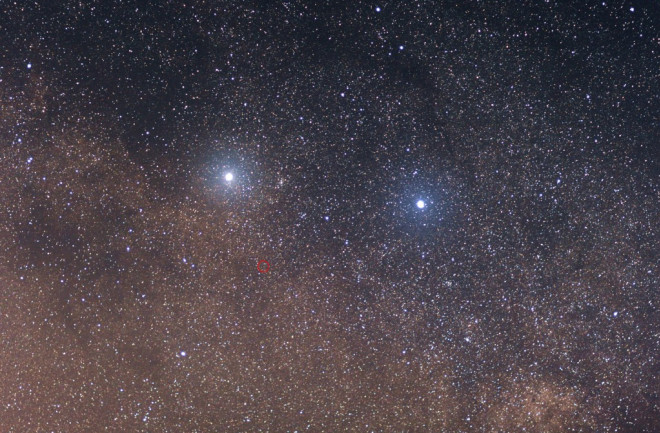
The field equations of Einstein’s General Relativity theory say that faster-than-light (FTL) travel is possible, so a handful of researchers are working to see whether a Star Trek -style warp drive, or perhaps a kind of artificial wormhole , could be created through our technology.
But even if shown feasible tomorrow, it’s possible that designs for an FTL system could be as far ahead of a functional starship as Leonardo da Vinci’s 16th century drawings of flying machines were ahead of the Wright Flyer of 1903. But this need not be a showstopper against human interstellar flight in the next century or two. Short of FTL travel, there are technologies in the works that could enable human expeditions to planets orbiting some of the nearest stars.
Picking the Target
Certainly, feasibility of such missions will depend on geopolitical-economic factors. But it also will depend on the distance to nearest Earth-like exoplanet. Located roughly 4.37 light years away, Alpha Centauri is the Sun’s closest neighbor; thus science fiction, including Star Trek , has envisioned it as humanity’s first interstellar destination.
In 2012, a planet was identified orbiting closely around Alpha Centauri B, one of three stars comprising the Alpha Centauri system. Three years later, astronomers were unable to find that same planet, but if it exists it would be too hot for life anyway. What we really want to know is whether planets exist further out from the two main stars, or whether their much smaller, dimmer companion star, Proxima Centauri, located just 4.24 light years from Earth, has planets of its own.
Very soon, these questions will be answered by the James Webb Space Telescope (JWST) that NASA will be launching into space in 2018, and by other instruments that will follow, instruments capable of more than merely detecting a planet’s presence. They will also be able to read the chemical composition of planetary atmospheres.
Imagine this: If there’s an Earth-like planet around Alpha Centauri or another nearby star system, astronomers will know about it within a decade or two — certainly long before we can build a ship like the Enterprise .
Maybe we could consider flying under the speed of light.
Propulsion
It is not widely known, but the US government spent real money, tested hardware and employed some of the best minds in late 1950s and early 60s to develop an idea called nuclear pulse propulsion .
Known as Project Orion , the work was classified because the principle was that your engine shoots a series of “nuclear pulse units” — atomic bombs of roughly Hiroshima/Nagasaki power — out the back. Each unit explodes and the shockwave delivers concussive force to an immense, steel pusher plate, which is connected to the most immense shock absorber system that you could imagine.
The researchers calculated that the ship could reach five percent the speed of light (0.05 c ), resulting in roughly a 90-year travel time to Alpha Centauri. The Nuclear Test Ban Treaty of 1963, which forbade nuclear explosions in the atmosphere, and the Outer Space Treaty of 1967, which forbade nuclear explosive devices in space, effectively ended Orion .
In his epic TV series Cosmos, Carl Sagan noted such an engine would be an excellent way to dispose of humanity’s nuclear bombs, but that it would have to be activated far from Earth. But back when Orion was being funded, amazingly, the plan was to use the nuclear pulse engine even for launching the vessel, in one massive piece, from the surface of Earth. Suffice it to say it does not seem likely that we’ll every build a nuclear pulse ship, but it’s something that we already have the technology to build.
A Cleaner System
But what about a less explosive, cleaner propulsion system that could achieve the same end? The British Interplanetary Society took on this goal in the 1970s with Project Daedalus . Named for the inventor from Greek mythology who built wings to escape the island of Crete, the design was based on projected development of inertial confinement fusion (ICF), one of two main strategies for generating nuclear fusion energy on Earth.
The other strategy is magnetic confinement fusion (MCF), and similar to ICF, designs exist for adapting MCF to space propulsion . Like Orion , a Daedalus craft would have to be rather large. But using deuterium and helium-3 (obtained from the lunar surface, or from Jupiter’s atmosphere) as fuel, Daedalus craft could reach 0.12 c , cutting travel time to Alpha Centauri to something like 40 years.
There are other ingenious ideas, such as the Bussard ramjet that could approach the speed of light, but the size of the engines and technological gaps that we must fill become so large that they may not seem easier than warp drive. So let’s limit our discussion to capabilities up to the neighborhood of the 0.12 c of Daedalus as we consider what form a human interstellar voyage might take
The Generation Starship
It has been said that if you want to go fast, go alone, but if you want to go far, go together. This proverb characterizes the strategy of building an interstellar ship so large that you don’t worry so much about the travel time.
Effectively, the ship is a space colony. It contains a large population — current estimates are that a minimum of tens of thousands of colonists are needed for a healthy gene pool — and all that is needed for people to live comfortably, but it follows a trajectory out of the solar system. Ideas for an interstellar ark taking millennia to reach a destination date back to the fathers of the Space Age — Russia’s Konstantin Tsiolkovsky and America’s Robert Goddard— — the idea really set sail with mid 20th century science fiction writers.
In a two-part novel series written in 1941, Robert A. Heinlein wrote of a vessel that took so long to reach its destination that the people aboard had forgotten they were on a ship. Instead, they believed the large craft to be their natural world.
Sending colonists on a voyage lasting centuries or millennia raises social questions, such as whether it is ethical to commit unborn generations to live out their lives in transit between planets.
10,000 years is a rather long time and means a large number of generations to commit to the interstellar void. But if we’re talking 40 or even 90 years, that’s probably more palatable to many more people. Still, it raises questions as to who would volunteer for such an expedition.
But what about people with shorter attention spans and what if we have no will to build enormous, moving colonies?
Here’s another science fiction strategy: sending cryopreserved human embryos, or gametes (ova and sperm) into deep space. Upon reaching the destination star system, the embryos would be developed. This would require an artificial uterus, which we don’t have yet, but like fusion, here we’re also talking in terms of a matter of decades.
At some point in this century, motherless birth could become a technological reality. Theoretically, we’ll be able to send cryopreserved embryos through space, for centuries if needed due to propulsion limitations, and set them to develop into full-term infants on the new planet.
Then, all you need are robot nannies to raise and educate the infant colonists. And if there’s one area of technological progress that people are supremely confident will keep advancing at warp speed, it’s robots and artificial intelligence.
The egg ship concept is loaded with ethical questions, which can be hashed out in the comments section.
Suspended Animation
As technically ambitious as it may sound, medical science is making incremental progress toward a safe form of human hibernation.
Currently, it’s routine to lower a patient’s body temperature intentionally by a few degrees, thereby inducing a mild hypothermic coma, following cardiac arrest. This enables the brain to recover after oxygen has been cut off, whereas remaining at normal body temperature results in what’s called reperfusion injury.
Not routine yet, but now under clinical trials, trauma surgeons are cooling patients down to just above freezing temperature in cases of severe blood loss. This is true suspended animation . It’s done just for two hours, or possibly three, stalling death so that injuries can be repaired and blood replaced, but the person is basically hibernating during that time.
With incremental progress, the procedure may eventually be extended to time frames of many hours, and eventually days or weeks to treat other conditions. Perhaps, in time, we’ll put people to sleep long enough, and with enough supervision by computers, to slumber away for an entire interstellar voyage the way you now doze off for a transoceanic flight.
- space exploration
- human spaceflight
- spaceflight
Already a subscriber?
Register or Log In

Keep reading for as low as $1.99!
Sign up for our weekly science updates.
Save up to 40% off the cover price when you subscribe to Discover magazine.
We have completed maintenance on Astronomy.com and action may be required on your account. Learn More

- Login/Register
- Solar System
- Exotic Objects
- Upcoming Events
- Deep-Sky Objects
- Observing Basics
- Telescopes and Equipment
- Astrophotography
- Space Exploration
- Human Spaceflight
- Robotic Spaceflight
- The Magazine
Warp drives: Physicists investigate faster-than-light space travel
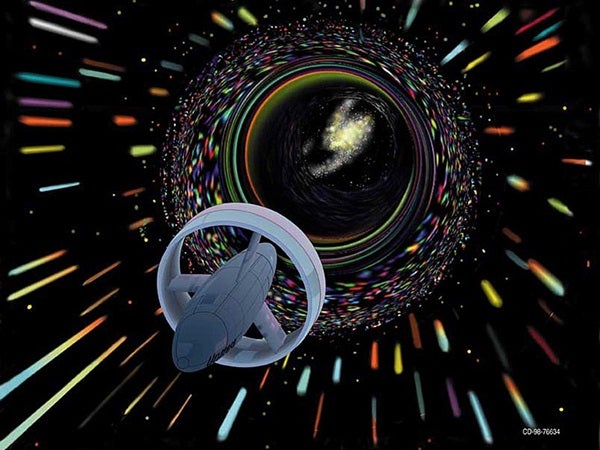
The closest star to Earth is Proxima Centauri. It is about 4.25 light-years away, or about 25 trillion miles (40 trillion kilometers). The fastest ever spacecraft, the now- in-space Parker Solar Probe will reach a top speed of 450,000 mph. It would take just 20 seconds to go from Los Angeles to New York City at that speed, but it would take the solar probe about 6,633 years to reach Earth’s nearest neighboring solar system.
If humanity ever wants to travel easily between stars, people will need to go faster than light. But so far, faster-than-light travel is possible only in science fiction.
In Issac Asimov’s Foundation series , humanity can travel from planet to planet, star to star or across the universe using jump drives. As a kid, I read as many of those stories as I could get my hands on. I am now a theoretical physicist and study nanotechnology, but I am still fascinated by the ways humanity could one day travel in space.
Some characters – like the astronauts in the movies “Interstellar” and “Thor” – use wormholes to travel between solar systems in seconds. Another approach – familiar to “Star Trek” fans – is warp drive technology. Warp drives are theoretically possible if still far-fetched technology. Two recent papers made headlines in March when researchers claimed to have overcome one of the many challenges that stand between the theory of warp drives and reality.
But how do these theoretical warp drives really work? And will humans be making the jump to warp speed anytime soon?
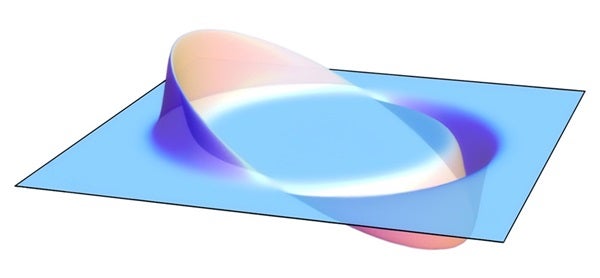
Compression and expansion
Physicists’ current understanding of spacetime comes from Albert Einstein’s theory of general relativity . General relativity states that space and time are fused and that nothing can travel faster than the speed of light. General relativity also describes how mass and energy warp spacetime – hefty objects like stars and black holes curve spacetime around them. This curvature is what you feel as gravity and why many spacefaring heroes worry about “getting stuck in” or “falling into” a gravity well. Early science fiction writers John Campbell and Asimov saw this warping as a way to skirt the speed limit.
What if a starship could compress space in front of it while expanding spacetime behind it? “Star Trek” took this idea and named it the warp drive.
In 1994, Miguel Alcubierre, a Mexican theoretical physicist, showed that compressing spacetime in front of the spaceship while expanding it behind was mathematically possible within the laws of General Relativity . So, what does that mean? Imagine the distance between two points is 33 feet (10 meters). If you are standing at point A and can travel one meter per second, it would take 10 seconds to get to point B. However, let’s say you could somehow compress the space between you and point B so that the interval is now just one meter. Then, moving through spacetime at your maximum speed of one meter per second, you would be able to reach point B in about one second. In theory, this approach does not contradict the laws of relativity since you are not moving faster than light in the space around you. Alcubierre showed that the warp drive from “Star Trek” was in fact theoretically possible.
Proxima Centauri here we come, right? Unfortunately, Alcubierre’s method of compressing spacetime had one problem: it requires negative energy or negative mass.
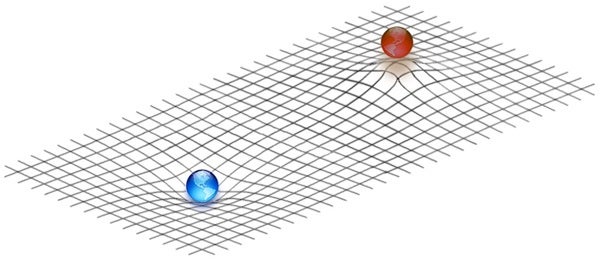
A negative energy problem
Alcubierre’s warp drive would work by creating a bubble of flat spacetime around the spaceship and curving spacetime around that bubble to reduce distances. The warp drive would require either negative mass – a theorized type of matter – or a ring of negative energy density to work. Physicists have never observed negative mass, so that leaves negative energy as the only option.
To create negative energy, a warp drive would use a huge amount of mass to create an imbalance between particles and antiparticles. For example, if an electron and an antielectron appear near the warp drive, one of the particles would get trapped by the mass and this results in an imbalance. This imbalance results in negative energy density. Alcubierre’s warp drive would use this negative energy to create the spacetime bubble.
But for a warp drive to generate enough negative energy, you would need a lot of matter. Alcubierre estimated that a warp drive with a 100-meter bubble would require the mass of the entire visible universe .
In 1999, physicist Chris Van Den Broeck showed that expanding the volume inside the bubble but keeping the surface area constant would reduce the energy requirements significantly , to just about the mass of the Sun. A significant improvement, but still far beyond all practical possibilities.
A sci-fi future?
Two recent papers – one by Alexey Bobrick and Gianni Martire and another by Erik Lentz – provide solutions that seem to bring warp drives closer to reality.
Bobrick and Martire realized that by modifying spacetime within the bubble in a certain way, they could remove the need to use negative energy. This solution, though, does not produce a warp drive that can go faster than light.
Independently, Lentz also proposed a solution that does not require negative energy. He used a different geometric approach to solve the equations of general relativity, and by doing so, he found that a warp drive wouldn’t need to use negative energy. Lentz’s solution would allow the bubble to travel faster than the speed of light.
It is essential to point out that these exciting developments are mathematical models. As a physicist, I won’t fully trust models until we have experimental proof. Yet, the science of warp drives is coming into view. As a science fiction fan, I welcome all this innovative thinking. In the words of Captain Picard , things are only impossible until they are not.

What Is Polaris Dawn? The upcoming SpaceX mission, explained
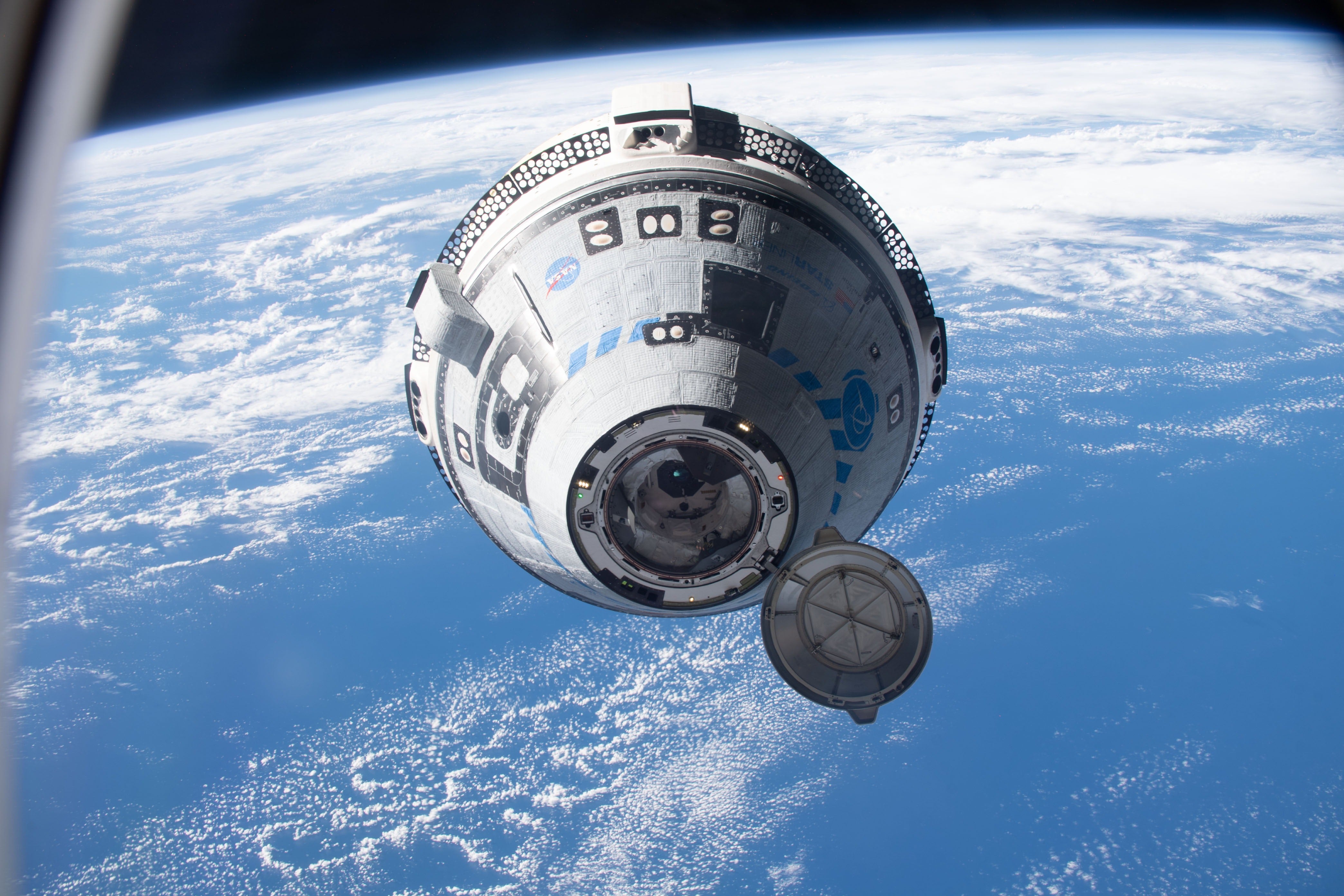
Boeing’s Starliner launch – delayed again – will be an important milestone for commercial spaceflight
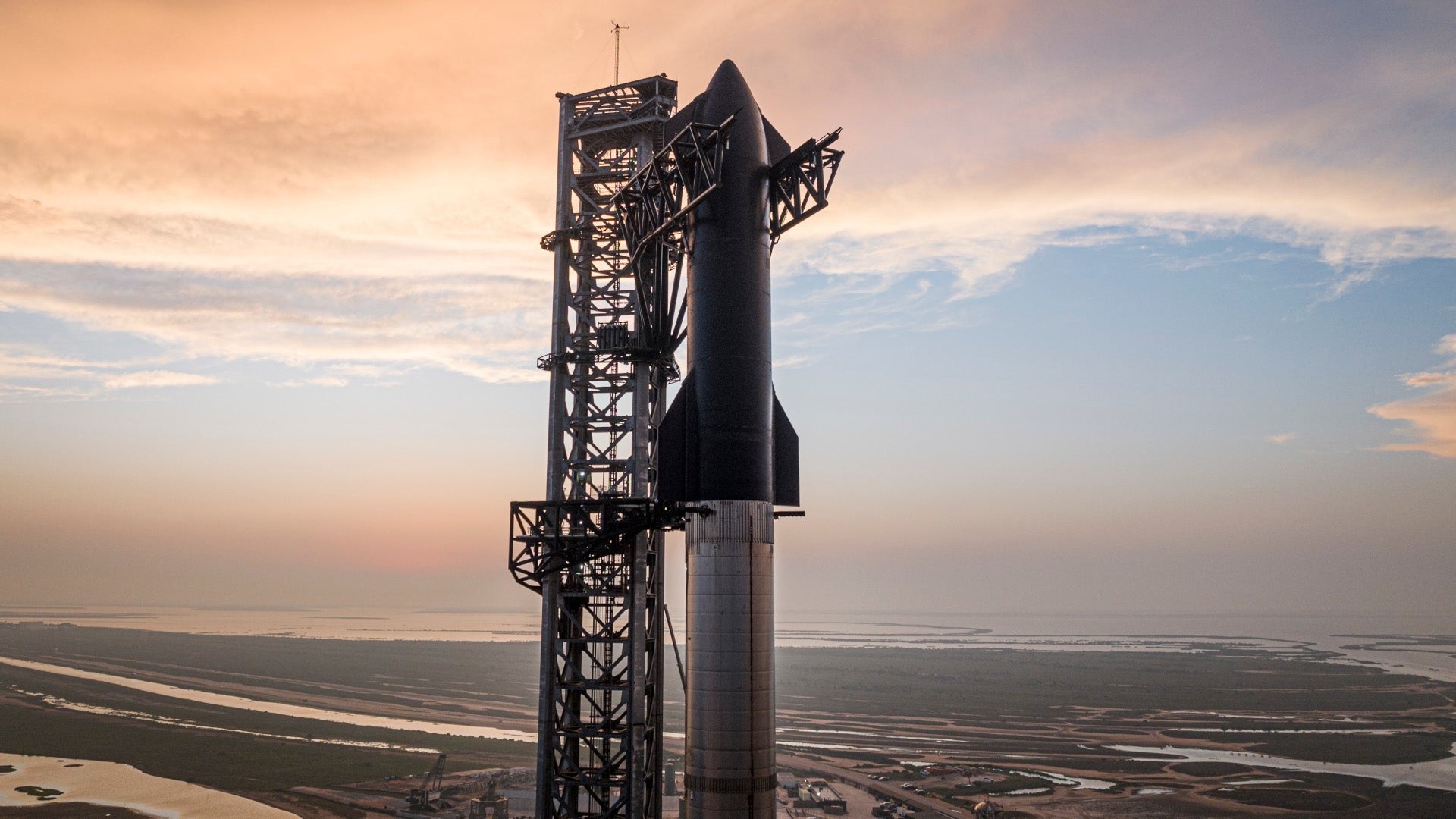
SpaceX adds tourism offering to website
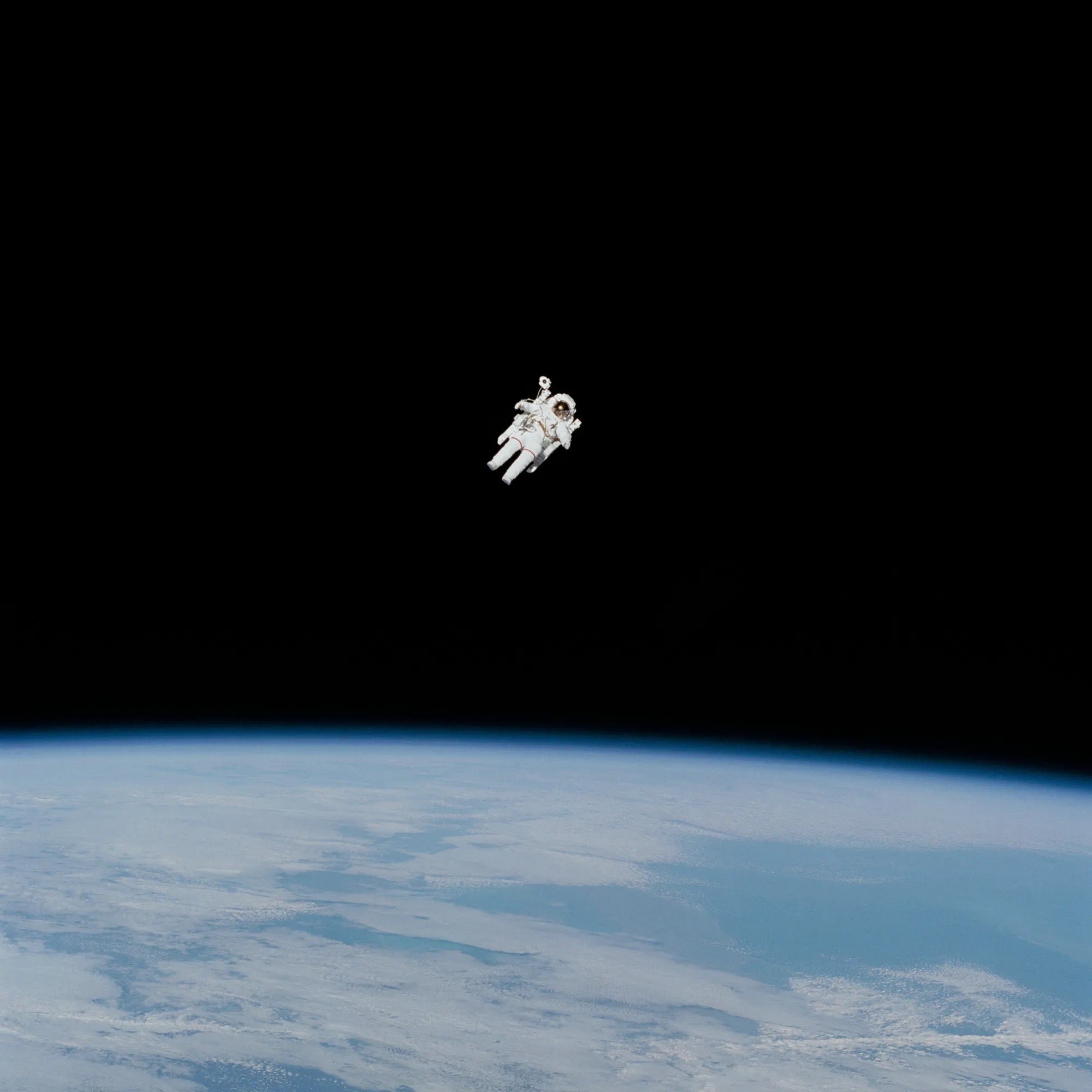
Astronauts have a surprising ability to gauge distances in space
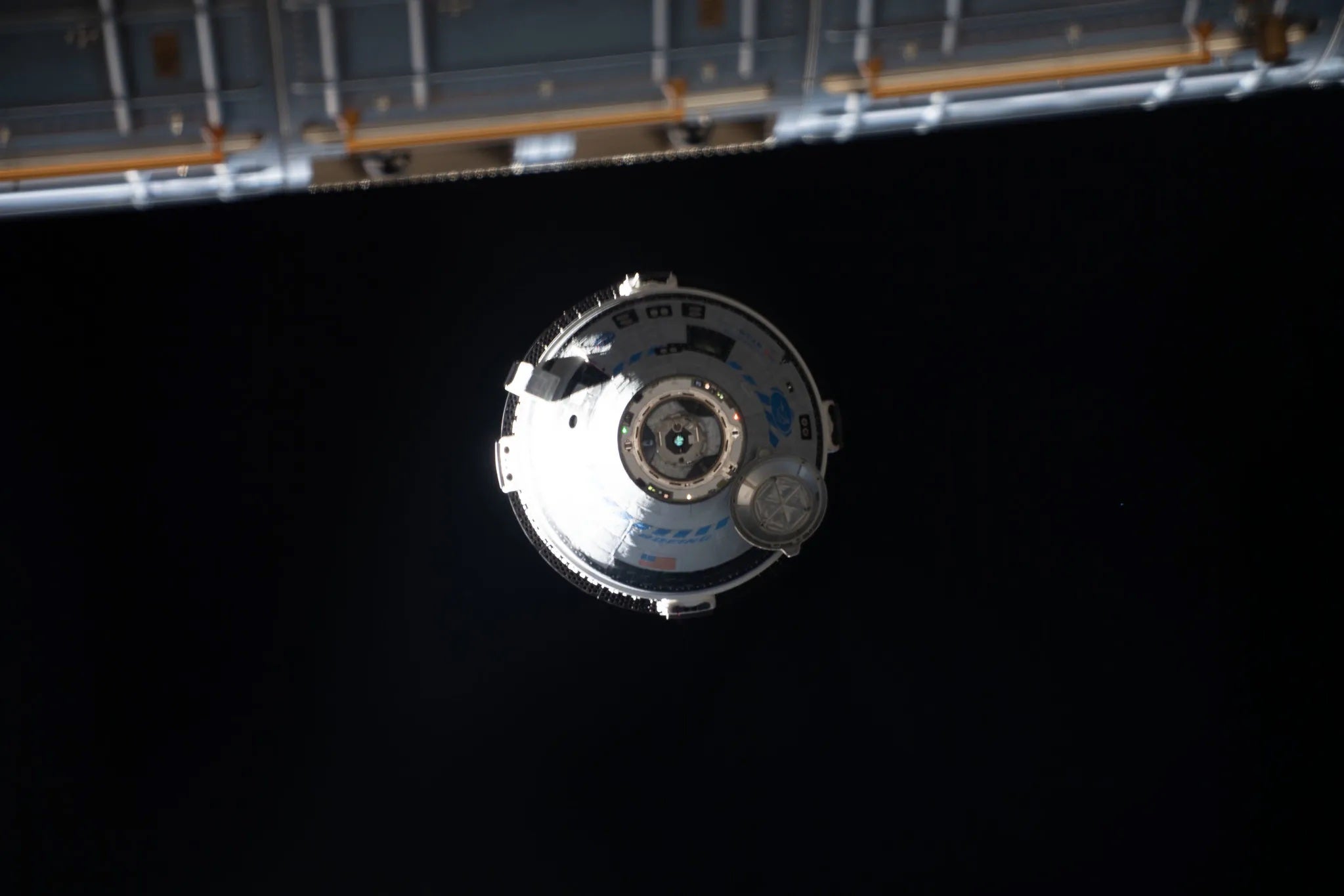
The NASA/Boeing Starliner launches soon. Here’s what to know.

What happens if someone dies in space?

Meet Katya Echazarreta, the first Mexican-born woman to travel to space

A metal chunk that burst through a Florida home came from the ISS

An updated list of space missions: Current and upcoming voyages
'Warp drives' may actually be possible someday, new study suggests
"By demonstrating a first-of-its-kind model, we've shown that warp drives might not be relegated to science fiction."

A new study provides some theoretical underpinning to warp drives, suggesting that the superfast propulsion tech may not forever elude humanity.
Sci-fi fans — especially " Star Trek " devotees — are familiar with warp drives . These hypothetical engines manipulate the fabric of space-time itself, compressing the stuff in front of a spaceship and expanding it behind. This creates a "warp bubble" that allows a craft to travel at incredible velocities — in some imaginings, many times faster than the speed of light .
In 1994, Mexican physicist Miguel Alcubierre published a groundbreaking paper that laid out how a real-life warp drive could work. This exciting development came with a major caveat, however: The proposed "Alcubierre drive" required negative energy, an exotic substance that may or may not exist (or, perhaps, the harnessing of dark energy , the mysterious force that seems to be causing the universe's accelerated expansion).
Related: Warp drive and 'Star Trek': The physics of future space travel
Alcubierre published his idea in Classical and Quantum Gravity. Now, a new paper in the same journal suggests that a warp drive may not require exotic negative energy after all.
"This study changes the conversation about warp drives," lead author Jared Fuchs, of the University of Alabama, Huntsville and the research think tank Applied Physics, said in a statement. "By demonstrating a first-of-its-kind model, we've shown that warp drives might not be relegated to science fiction."
The team's model uses "a sophisticated blend of traditional and novel gravitational techniques to create a warp bubble that can transport objects at high speeds within the bounds of known physics," according to the statement.
Get the Space.com Newsletter
Breaking space news, the latest updates on rocket launches, skywatching events and more!
Understanding that model is probably beyond most of us; the paper's abstract, for example, says that the solution "involves combining a stable matter shell with a shift vector distribution that closely matches well-known warp drive solutions such as the Alcubierre metric."
The proposed engine could not achieve faster-than-light travel, though it could come close; the statement mentions "high but subluminal speeds."
— How 'Star Trek' technology works (infographic)
— Warp speed: The hype of hyperspace
— What is dark energy?
This is a single modeling study, so don't get too excited. Even if other research teams confirm that the math reported in the new study checks out, we're still very far from being able to build an actual warp drive.
Fuchs and his team admit as much, stressing that their work could end up being a stepping stone on the long road to efficient interstellar flight.
"While we're not yet preparing for interstellar voyages, this research heralds a new era of possibilities," Gianni Martire, CEO of Applied Physics, said in the same statement. "We're continuing to make steady progress as humanity embarks on the Warp Age."
The team's study was published online on April 29. You can find it here , though all but the abstract is behind a paywall; a free preprint version is available via arXiv.org.
Join our Space Forums to keep talking space on the latest missions, night sky and more! And if you have a news tip, correction or comment, let us know at: [email protected].

Michael Wall is a Senior Space Writer with Space.com and joined the team in 2010. He primarily covers exoplanets, spaceflight and military space, but has been known to dabble in the space art beat. His book about the search for alien life, "Out There," was published on Nov. 13, 2018. Before becoming a science writer, Michael worked as a herpetologist and wildlife biologist. He has a Ph.D. in evolutionary biology from the University of Sydney, Australia, a bachelor's degree from the University of Arizona, and a graduate certificate in science writing from the University of California, Santa Cruz. To find out what his latest project is, you can follow Michael on Twitter.
Lego Marvel The Amazing Spider-Man review
Lego Star Wars Millennium Falcon (2024) review
Watch monster flare-spewing sunspot grow to be 15 times wider than Earth (video)
- MikeEz I would be interested in Dr. Alcubierre and Dr. Whites' responses. Reply
- billslugg It uses standard physics and does not allow FTL travel, according to the article. What's the point? Reply
- Questioner I think what they are saying is it creates an independent frame of reference. That it is dislodged from standard spatial continuity. That would be the first step to superluminal Alcubierri methodology. It also might evade luminal proximate collisions with space detrimous. But that's just my take. Reply
- Pogo We’ve been launching stuff beyond Earth’s atmosphere for 67 years now and haven’t gotten beyond 0.064c thus far. This warp thing is still only one team’s theory. It’ll likely be generations before we get even a subatomic particle into this warp speed thing, if ever. If it ever does become practical, it could be used to send small probes to local stars in a reasonable timeline. Anything manned will not likely be practical. The article doesn’t mention if warp drive actually negates relativistic effects. Reply
- billslugg All of the theories that would have us go FTL are based on solutions to Einstein's field equations. That they solve the equations does not necessarily mean they can exist in reality. Here is an example: The area of a square is given by x^2. Two negative numbers can solve the equation just as well as two positive numbers can. But there is no such thing as negative length. Headline: "Scientists find solution to area problem that involves negative length, thus it must exist". Another reason we can't go FTL. If one goes FTL, one must necessarily pass through c. At that point, the item would require all of the mass in the universe be converted into its kinetic energy. In other words: "You can't get there from here". Reply
billslugg said: It uses standard physics and does not allow FTL travel, according to the article. What's the point?
- billslugg Valid points. When they actually come up with some of the exotic matter they need, then I'll get on board. Reply
Pogo said: The article doesn’t mention if warp drive actually negates relativistic effects.
Mizagorn said: That was my first thought. You're part of the crew. You get paid by the hour and you're on the clock. Do you go by the onboard clock or the one back at the office? 🤔
Admin said: A new study provides some theoretical underpinning to sci-fi warp drives, suggesting that the superfast propulsion tech may not forever elude humanity. Warp drives' may actually be possible someday, new study suggests : Read more
- View All 33 Comments
Most Popular
- 2 Cracking! Some binary black holes may roll around each other in egg-shaped orbits
- 3 NASA's Roman Space Telescope will hunt for the universe's 1st stars — or their shredded corpses, anyway
- 4 Our neighboring galaxy's supermassive black hole would probably be a polite dinner guest
- 5 'God of Destruction' asteroid Apophis will come to Earth in 2029 — and it could meet some tiny spacecraft

New warp drive research dashes faster than light travel dreams – but reveals stranger possibilities
Associate professor, Australian Catholic University
Disclosure statement
Sam Baron receives funding from the Australian Research Council.
Australian Catholic University provides funding as a member of The Conversation AU.
View all partners
In 1994, physicist Miguel Alcubierre proposed a radical technology that would allow faster than light travel: the warp drive , a hypothetical way to skirt around the universe’s ultimate speed limit by bending the fabric of reality.
It was an intriguing idea – even NASA has been researching it at the Eagleworks laboratory – but Alcubierre’s proposal contained problems that seemed insurmountable. Now, a recent paper by US-based physicists Alexey Bobrick and Gianni Martire has resolved many of those issues and generated a lot of buzz .
But while Bobrick and Martire have managed to substantially demystify warp technology, their work actually suggests that faster-than-light travel will remain out of reach for beings like us, at least for the time being.
There is, however, a silver lining: warp technology may have radical applications beyond space travel.
Across the universe?
The story of warp drives starts with Einstein’s crowning achievement: general relativity. The equations of general relativity capture the way in which spacetime – the very fabric of reality – bends in response to the presence of matter and energy which, in turn, explains how matter and energy move.
General relativity places two constraints on interstellar travel. First, nothing can be accelerated past the speed of light (around 300,000 km per second). Even travelling at this dizzying speed it would still take us four years to arrive at Proxima Centauri, the nearest star to our Sun.
Second, the clock on a spaceship travelling close to the speed of light would slow down relative to a clock on Earth (this is known as time dilation). Assuming a constant state of acceleration, this makes it possible to travel the stars. One can reach a distant star that is 150 lightyears away within one’s lifetime. The catch, however, is that upon one’s return more than 300 years will have passed on Earth.
This is where Alcubierre came in. He argued that the mathematics of general relativity allowed for “warp bubbles” – regions where matter and energy were arranged in such a way as to bend spacetime in front of the bubble and expand it to the rear in a way that allowed a “flat” area inside the bubble to travel faster than light.
Read more: Don't stop me now! Superluminal travel in Einstein's universe
To get a sense of what “flat” means in this context, note that spacetime is sort of like a rubber mat. The mat curves in the presence of matter and energy (think of putting a bowling ball on the mat). Gravity is nothing more than the tendency objects have to roll into the the dents created by things like stars and planets. A flat region is like a part of the mat with nothing on it.
Such a drive would also avoid the uncomfortable consequences of time dilation. One could potentially make a round trip into deep space and still be greeted by one’s nearest and dearest at home.
A spacetime oddity
How does Alcubierre’s device work? Here discussion often relies on analogies, because the maths is so complex.
Imagine a rug with a cup on it. You’re on the rug and you want to get to the cup. You could move across the rug, or tug the rug toward you. The warp drive is like tugging on spacetime to bring your destination closer.
But analogies have their limits: a warp drive doesn’t really drag your destination toward you. It contracts spacetime to make your path shorter. There’s just less rug between you and the cup when you switch the drive on.
Alcubierre’s suggestion, while mathematically rigorous, is difficult to understand at an intuitive level. Bobrick and Martire’s work is set to change all that.
Starship bloopers
Bobrick and Martire show that any warp drive must be a shell of material in a constant state of motion, enclosing a flat region of spacetime. The energy of the shell modifies the properties of the spacetime region inside it.
This might not sound like much of a discovery, but until now it was unclear what warp drives might be, physically speaking. Their work tells us that a warp drive is, somewhat surprisingly, like a car. A car is also a shell of energy (in the form of matter) that encloses a flat region of spacetime. The difference is that getting inside a car does not make you age faster. That, however, is the kind of thing a warp drive might do.
Using their simple description, Bobrick and Martire demonstrate a method for using Einstein’s general relativity equations to find spacetimes that allow for arrangements of matter and energy that would act as warp bubbles. This gives us a mathematical key for finding and classifying warp technologies.
Their work manages to address one of the core problems for warp drives. To make the equations balance, Alcubierre’s device runs on “negative energy” – but we are yet to discover any viable sources of negative energy in the real world.

Worse, the negative energy requirements of Alcubierre’s device are immense. By some estimates, the entire energy in the known universe would be needed (though later work brings the number down a bit).
Bobrick and Martire show a warp drive could be made from positive energy (i.e. “normal” energy) or from a mixture of negative and positive energy. That said, the energy requirements would still be immense.
If Bobrick and Martire are right, then a warp drive is just like any other object in motion. It would be subject to the universal speed limit enforced by general relativity after all, and it would need some kind of conventional propulsion system to make it accelerate.
The news gets worse. Many kinds of warp drive can only modify the spacetime inside in a certain way: by slowing down the clock of the passenger in exactly the way that makes a trip into deep space a problem.
Bobrick and Martire do show that some warp drives could travel faster than light, but only if they are created already travelling at that speed – which is no help for any ordinary human hoping for a bit of interstellar tourism.
The end game
Remember that a warp drive can modify the region of flat spacetime it encloses. It can, in particular, speed up or slow down a clock inside the drive.
Consider what it would mean to have such an object available. Want to put someone with a terminal illness on ice? Stick them in a warp drive and slow their clock down. From their perspective, a few years will pass, while a hundred years will pass on Earth — time enough to find a cure.
Read more: The art and beauty of general relativity
Want to grow your crops overnight? Stick them in a warp drive and speed the clock up. A few days will pass for you, and a few weeks will pass for your seedlings.
There are even more exotic possibilities: by rotating the spacetime inside a drive one may be able to produce a battery capable of holding huge amounts of energy.
Faster-than-light travel remains a distant dream. But warp technology would be revolutionary in its own right.
- Time travel
- General Relativity
- Space travel
- Theoretical physics

Events and Communications Coordinator

Assistant Editor - 1 year cadetship

Executive Dean, Faculty of Health

Lecturer/Senior Lecturer, Earth System Science (School of Science)

Sydney Horizon Educators (Identified)

Scientists Believe Light Speed Travel Is Possible. Here’s How.
A functioning warp drive would allow humans to reach the far ends of the cosmos in the blink of an eye.
White and his team in LSI’s Houston laboratory were conducting research for the Defense Advanced Research Projects Agency, or DARPA, and had set up these particular experiments to study the energy densities within Casimir cavities, the mysterious spaces between microscopic metal plates in a vacuum. The data plot indicated areas of diminished energy between the plates, which caused them to push toward each other as if trying to fill the void. This is known as negative vacuum energy density, a phenomenon in quantum mechanics called, appropriately enough, the Casimir effect . It’s something that’s helping scientists understand the soupy physics of microscale structures, which some researchers hope can be applied to energy applications that are more practical, such as circuits and electromechanical systems.
But White noticed that the pattern of negative vacuum energy between the plates and around tiny cylindrical columns that they’d inserted in the space looked familiar. It precisely echoed the energy pattern generated by a type of exotic matter that some physicists believe could unlock high-speed interstellar travel. “We then looked, mathematically, at what happens if we placed a one-micron sphere inside of a four-micron cylinder under the same conditions, and found that this kind of structure could generate a little nanoscale warp bubble encapsulating that central region,” White explains.
That’s right—a warp bubble. The essential component of a heretofore fictional warp drive that has for decades been the obsession of physicists, engineers, and sci-fi fans. Warp drive, of course, is the stuff of Star Trek legend, a device enclosed within a spacecraft that gives the mortals aboard the ability to rip around the cosmos at superhuman speed. To the lay sci-fi fan, it’s a “black box”—a convenient, completely made-up workaround to avoid the harsh realities of interstellar travel. However, after decades of speculation, research, and experimentation, scientists believe a warp drive could actually work.
To emphasize: White didn’t actually make a warp bubble. But the data from his study led to an aha moment: For the first time, a buildable warp bubble showed promise of success.

Warp technology’s core science is surprisingly sound. Though the specific mechanics of an actual device haven’t been fully unpacked, the math points toward feasibility. In short, a real-life warp drive would use massive amounts of energy, which can come in the form of mass, to create enough gravitational pull to distort spacetime in a controlled fashion, allowing a ship to speed along inside a self-generated bubble that itself is able to travel at essentially any speed. Warp drives popped up in fiction intermittently for several decades before Star Trek creator Gene Roddenberry plugged one into the USS Enterprise in 1966. But Miguel Alcubierre, PhD, a Mexican theoretical physicist and professed Star Trek enthusiast, gave the idea real-world legs when he released a paper in 1994 speculating that such a drive was mathematically possible. It was the first serious treatment of a warp drive’s feasibility, and it made headlines around the world. His breakthrough inspired more scientists to nudge the theoretical aspects of warp drive toward concrete, practical applications.
“I proposed a ‘geometry’ for space that would allow faster-than-light travel as seen from far away, essentially expanding space behind the object we want to move and contracting it in front,” Alcubierre says. “This forms a ‘bubble’ of distorted space, inside of which an object—a spaceship, say—could reside.”
Physicists tend to speak in relative terms. By injecting the sly qualifier “as seen from far away,” Alcubierre might sound like he’s describing the galactic equivalent of an optical illusion —an effect perhaps similar to driving past a truck going the opposite direction on the highway when you’re both going 60 miles an hour. Sure feels like a buck-twenty, doesn’t it? But the A-to-B speed is real; the warp effect simply shortens the literal distance between two points. You’re not, strictly speaking, moving faster than light. Inside the bubble, all appears relatively normal, and light moves faster than you are, as it should. Outside the bubble, however, you’re haulin’ the mail.
.css-2l0eat{font-family:UnitedSans,UnitedSans-roboto,UnitedSans-local,Helvetica,Arial,Sans-serif;font-size:1.625rem;line-height:1.2;margin:0rem;padding:0.9rem 1rem 1rem;}@media(max-width: 48rem){.css-2l0eat{font-size:1.75rem;line-height:1;}}@media(min-width: 48rem){.css-2l0eat{font-size:1.875rem;line-height:1;}}@media(min-width: 64rem){.css-2l0eat{font-size:2.25rem;line-height:1;}}.css-2l0eat b,.css-2l0eat strong{font-family:inherit;font-weight:bold;}.css-2l0eat em,.css-2l0eat i{font-style:italic;font-family:inherit;} THOUGH THE SPECIFIC MECHANICS OF AN ACTUAL DEVICE HAVEN’T BEEN UNPACKED, THE MATH POINTS TOWARD FEASIBILITY.
Alcubierre’s proposal had solved one of the initial hurdles to achieving warp speeds: The very idea clashes with Einstein’s long-accepted theory of general relativity, which states that nothing can travel faster than the speed of light, but it doesn’t preclude space itself from traveling faster than that. In fact, scientists speculate that the same principles explain the rapid expansion of the universe after the Big Bang .
While concluding that warp speed was indeed possible, Alcubierre also found that it would require an enormous amount of energy to sustain the warp bubble. He theorized that negative energy—the stuff hinted at by White’s experimentation with Casimir cavities—could be a solution. The only problem is that no one has yet proved that negative energy is real. It’s the unobtanium of our spacefaring imaginations, something researchers only believe to exist. In theory, however, this unknown matter may be sufficiently powerful that future warp drive designers could channel it to contract spacetime around it. In conceptual drawings of warp-capable spacecraft , enormous material rings containing this energy source surround a central fuselage. When activated, it warps spacetime around the entire ship. The more intense the warping, the faster the warp travel is achieved.
Of course, it’s not that simple. Physicist José Natário, PhD, a professor at the Instituto Superior Técnico in Lisbon, wrote his own influential paper about the mathematical feasibility of warp drives in 2001. However, he is concerned about practical conundrums, like the amount of energy required. “You need to be able to curve spacetime quite a lot in order to do this,” he says. “We’re talking about something that would be much, much more powerful than the sun.”
Alcubierre is similarly skeptical that his theoretical ideas might ever be used to develop a working warp drive. “In order to have a bubble about 100 meters wide traveling at precisely the speed of light, you would need about 100 times the mass of the planet Jupiter converted into negative energy, which of course sounds absurd,” he says. By that standard, he concludes, a warp drive is very unlikely.
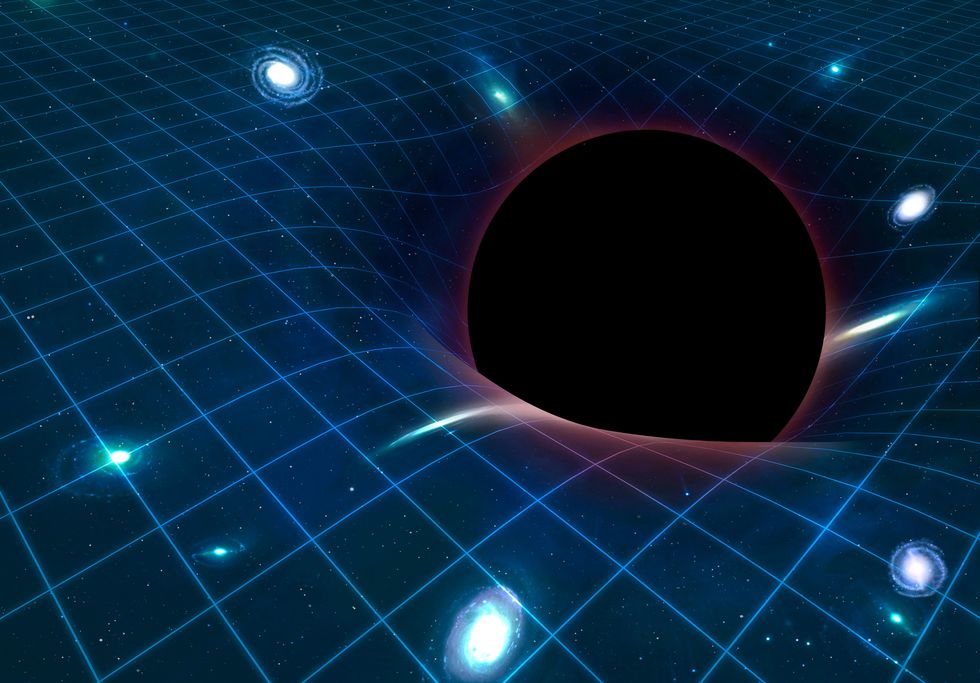
Physicists love a challenge, though. In the 29 years since Alcubierre published his paper, other scientists have wrestled with the implications of the work, providing alternative approaches to generating the energy using more accessible power sources, finding oblique entry points to the problem, and batting ideas back and forth in response to one another’s papers. They use analogies involving trampolines , tablecloths, bowling balls, balloons, conveyor belts, and music to explain the physics.
They even have their own vocabulary. It’s not faster-than-light travel; it’s superluminal travel, thank you. Then there’s nonphysical and physical—a.k.a. the critical distinction between theoretical speculation and something that can actually be engineered. (Pro tip: We’re aiming for physical here, folks.) They do mention Star Trek a lot, but never Star Wars . Even the scruffiest-looking nerf herder knows that the ships in Star Wars use hyperdrive, which consumes fuel, rather than warp drives, which don’t use propulsive technology but instead rely on, well, warping. They’re also vague about details like what passengers would experience, what gravity is like on board since you’re carrying around boatloads of energy, and what would happen if someone, say, jumped out of the ship while warping. (A speculative guess: Nothing good.)
Such research isn’t typically funded by academic institutions or the DARPAs and NASAs of the world, so much of this work occurs in the scientists’ spare time. One such scientist and Star Trek enthusiast is physicist Erik Lentz, PhD. Now a researcher at Pacific Northwest National Laboratory in Richland, Washington, Lentz was doing postdoctoral work at Göttingen University in Germany when, amid the early, isolated days of the pandemic, he mulled the idea of faster-than-light travel. He published a paper in 2021 arguing that warp drives could be generated using positive energy sources instead of the negative energy that Alcubierre’s warp drive seemed to require.
“There are a number of barriers to entry to actually being able to build a warp drive,” Lentz says. “The negative energy was the most obvious, so I tried to break that barrier down.”
He explored a new class of solutions in Einstein’s general relativity while focusing on something called the weak-energy condition, which, he explains, tracks the positivity of energy in spacetime. He hit upon a “soliton solution”—a wave that maintains its shape and moves at a constant velocity—that could both satisfy the energy-level challenge and travel faster than light. Such a warp bubble could travel along using known energy sources, though harnessing those at the levels needed are still far beyond our capabilities. The next step, he notes, may be bringing the energy requirements for a warp drive to within the range of a nuclear fusion reactor.
A fusion-powered device could theoretically travel to and from Proxima Centauri , Earth’s nearest star, in years instead of decades or millennia, and then go faster and faster as power sources improve. Current conventional rocket technology, on the other hand, would take 50,000 years just for a one-way trip—assuming, of course, there was an unlimited fuel supply for those engines.
“IF YOU COLLIDE WITH SOMETHING ON YOUR PATH, IT WOULD ALMOST CERTAINLY BE CATASTROPHIC.”
Like Alcubierre’s original thesis, Lentz’s paper had a seismic impact on the warp drive community, prompting yet another group of scientists to dig into the challenge. Physicist Alexey Bobrick and technology entrepreneur Gianni Martire have been particularly prolific. In 2021, they released a paper theorizing that a class of subliminal warp drives, traveling at just a fraction of light speed, could be developed from current scientific understanding. While that paper essentially argued that it’s perfectly acceptable to walk before you can run, they followed it up with another theory earlier this year that describes how a simulated black hole , created using sound waves and glycerin and tested with a laser beam, could be used to evaluate the levels of gravitational force needed to warp spacetime. The duo coded that breakthrough into a public app that they hope will help more quickly push theoretical ideas to practical ones. Though the team is waiting for the technology to clear a peer review stage before releasing details, the app is essentially a simulator that allows scientists to enter their warp-speed equations to validate whether they’re practical.
“When somebody publishes a warp metric for the first time, people say, ‘Okay, is your metric physical?’” Martire says. The answer to that question—whether the metric has practical potential or is strictly theoretical—is hard to establish given the challenges of testing these hypotheses. That determination could take six to eight months. “Now we can tell you within seconds, and it shows you visually how off you are or how close you are,” he says.
While useful, the app will speed up the preliminary math only for future researchers. Galaxy-sized challenges remain before we ever experience turbocharged interstellar travel. Alcubierre worries in particular about what may happen near the walls of the warp bubble. The distortion of space is so violent there, he notes, that it would destroy anything that gets close. “If you collide with something on your path, it would almost certainly be catastrophic,” he says.
Natário mulls even more practical issues, like steering and stopping. “It’s a bubble of space, that you’re pushing through space,” he says. “So, you’d have to tell space ... to curve in front of your spaceship.” But therein lies the problem: You can’t signal to the space in front of you to behave the way you want it to.
His opinion? Superluminal travel is impossible. “You need these huge deformations that we have no idea how to accomplish,” Natário says. “So yes, there has been a lot of effort toward this and studying these weird solutions, but this is all still completely theoretical, abstract, and very, very, very, very far from getting anywhere near a practical warp drive.” That’s “very” to the power of four, mind you—each crushing blow pushing us exponentially, excruciatingly further and further away from our yearned-for superluminal lives.
Ultimately, the pursuit of viable high-speed interstellar transportation also points to a more pressing terrestrial challenge: how the scientific community tackles ultra-long-term challenges in the first place. Most of the research so far has come from self-starters without direct funding, or by serendipitous discoveries made while exploring often unrelated research, such as Dr. White’s work on Casimir cavities.
Many scientists argue that we’re in a multi-decade period of stagnation in physics research, and warp drive—despite its epic time horizons before initial research leads to galaxy-spanning adventures—is somewhat emblematic of that stagnation. Sabine Hossenfelder, a research fellow at the Frankfurt Institute for Advanced Studies and creator of the YouTube channel Science Without the Gobbledygook , noted in a 2020 blog post that physics research has drifted away from frequent, persistent physical experimentation to exorbitant infusions of cash into relatively few devices. She writes that with fewer experiments, serendipitous discoveries become increasingly unlikely. Without those discoveries, the technological progress needed to keep experiments economically viable never materializes.
When asked whether this applied equally to warp drive, Hossenfelder sees a faint but plausible connection. “Warp drives are an idea that is not going to lead to applications in the next 1,000 years or so,” she says. “So they don’t play a big role in that one way to another. But when it comes to the funding, you see some overlap in the problems.”
So, despite all the advances, the horizon for a warp drive remains achingly remote. That hasn’t fazed the scientists involved, though. A few years ago, while teaching in France, White visited the Strasbourg Cathedral with his wife. While admiring its 466-foot-tall spire, he was struck by the fact that construction began in 1015 but didn’t wrap up until 1439—a span of 424 years. Those who built the basement had no chance of ever seeing the finished product, but they knew they had to do their part to aid future generations. “I don’t have a crystal ball,” White says. “I don’t know what the future holds. But I know what I need to be doing right now.”
Eric Adams is a writer and photographer who focuses on technology, transportation, science, travel, and other subjects for a wide range of outlets, including Wired, The Drive, Gear Patrol, Men's Health, Popular Science, Forbes, and others.

.css-cuqpxl:before{padding-right:0.3125rem;content:'//';display:inline;} Pop Mech Pro .css-xtujxj:before{padding-left:0.3125rem;content:'//';display:inline;}

Overhaul Your Shop

The Source of All Consciousness May Be Black Holes

F-22s are Flocking to This Island in the Pacific

Special Ops Gunship Shreds “Fishing Boat”

Russia's Unprecedented Nuclear Drills
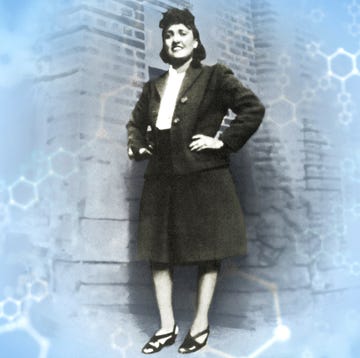
Henrietta Lacks Never Asked to Be Immortal

Ukraine Is Using an Ancient Weapon on Russia

Inside the CIA’s Quest to Steal a Soviet Sub

Jumpstart Your Car With a Cordless Tool Battery

Lost Villa of Rome’s Augustus Potentially Found

Could Freezing Your Brain Help You Live Forever?

- May 10, 2024 | Revolutionary Battery Tech Promises Less Charging Time, More Energy Storage
- May 10, 2024 | Quantum Entanglement Unmasked by Entanglement Witnesses
- May 10, 2024 | Innovative Study Reveals How Addiction Hijacks Brain Functions
- May 10, 2024 | New Research Could Lead to More Efficient Televisions, Computer Screens and Lighting
- May 10, 2024 | How Satellite Technology Is Rewriting Tiger Conservation
Breaking the Warp Barrier for Faster-Than-Light Travel: New Theoretical Hyper-Fast Solitons Discovered
By University of Göttingen March 11, 2021

Artistic impression of different spacecraft designs considering theoretical shapes of different kinds of “warp bubbles.” Credit: E Lentz
Astrophysicist at Göttingen University discovers new theoretical hyper-fast soliton solutions.
If travel to distant stars within an individual’s lifetime is going to be possible, a means of faster-than-light propulsion will have to be found. To date, even recent research about superluminal (faster-than-light) transport based on Einstein’s theory of general relativity would require vast amounts of hypothetical particles and states of matter that have “exotic” physical properties such as negative energy density. This type of matter either cannot currently be found or cannot be manufactured in viable quantities. In contrast, new research carried out at the University of Göttingen gets around this problem by constructing a new class of hyper-fast ‘solitons’ using sources with only positive energies that can enable travel at any speed. This reignites debate about the possibility of faster-than-light travel based on conventional physics. The research is published in the journal Classical and Quantum Gravity.
The author of the paper, Dr. Erik Lentz, analyzed existing research and discovered gaps in previous ‘warp drive’ studies. Lentz noticed that there existed yet-to-be explored configurations of space-time curvature organized into ‘solitons’ that have the potential to solve the puzzle while being physically viable. A soliton – in this context also informally referred to as a ‘warp bubble’ – is a compact wave that maintains its shape and moves at constant velocity. Lentz derived the Einstein equations for unexplored soliton configurations (where the space-time metric’s shift vector components obey a hyperbolic relation), finding that the altered space-time geometries could be formed in a way that worked even with conventional energy sources. In essence, the new method uses the very structure of space and time arranged in a soliton to provide a solution to faster-than-light travel, which – unlike other research – would only need sources with positive energy densities. No “exotic” negative energy densities needed.
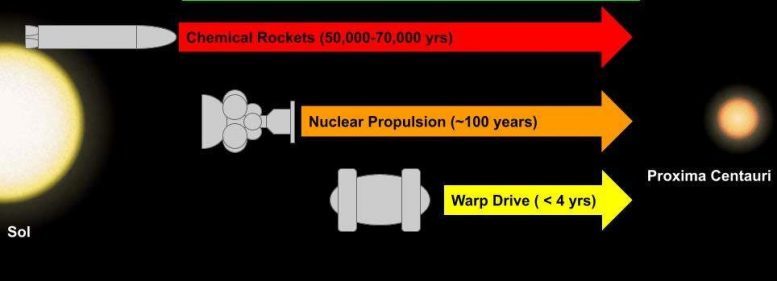
Image to show how long it would take different types of spacecraft to travel from our solar system to Proxima Centauri (the nearest known star). Currently, the only option would be to use a chemical rocket meaning a journey time of over 50,000 years. Credit: E Lentz
If sufficient energy could be generated, the equations used in this research would allow space travel to Proxima Centauri, our nearest star, and back to Earth in years instead of decades or millennia. That means an individual could travel there and back within their lifetime. In comparison, the current rocket technology would take more than 50,000 years for a one-way journey. In addition, the solitons (warp bubbles) were configured to contain a region with minimal tidal forces such that the passing of time inside the soliton matches the time outside: an ideal environment for a spacecraft. This means there would not be the complications of the so-called “twin paradox” whereby one twin traveling near the speed of light would age much more slowly than the other twin who stayed on Earth: in fact, according to the recent equations both twins would be the same age when reunited.
“This work has moved the problem of faster-than-light travel one step away from theoretical research in fundamental physics and closer to engineering. The next step is to figure out how to bring down the astronomical amount of energy needed to within the range of today’s technologies, such as a large modern nuclear fission power plant. Then we can talk about building the first prototypes,” says Lentz.
Currently, the amount of energy required for this new type of space propulsion drive is still immense. Lentz explains, “The energy required for this drive traveling at light speed encompassing a spacecraft of 100 meters in radius is on the order of hundreds of times of the mass of the planet Jupiter . The energy savings would need to be drastic, of approximately 30 orders of magnitude to be in range of modern nuclear fission reactors.” He goes on to say: “Fortunately, several energy-saving mechanisms have been proposed in earlier research that can potentially lower the energy required by nearly 60 orders of magnitude.” Lentz is currently in the early-stages of determining if these methods can be modified, or if new mechanisms are needed to bring the energy required down to what is currently possible.
Reference: “Breaking the warp barrier: hyper-fast solitons in Einstein–Maxwell- plasma theory” by Erik W Lentz, 9 March 2021, Classical and Quantum Gravity . DOI: 10.1088/1361-6382/abe692
More on SciTechDaily
Quantum magic squares cannot be as easily characterized as their “classical” cousins.

Can We Make Opioids Less Addictive? [Video]

Meltwater Pulse 1A: Melting Ice Sheets Caused Sea Levels to Rise Up to 18 Meters

Stromatolites – Fossils of Earliest Life on Earth – May Owe Their Very Existence to Viruses

Giant Millipedes “As Big as Cars” Once Roamed Northern England – “Complete Fluke of a Discovery”
Did a black hole eating a star generate a neutrino new research casts doubt.

America Must Prepare for COVID-19 Related Drug Shortages
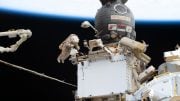
Cosmonauts Begin Spacewalk To Move Roscosmos Radiator on Space Station
22 comments on "breaking the warp barrier for faster-than-light travel: new theoretical hyper-fast solitons discovered".
“Sufficient Energy” This already exist in the form of Element 115. If the Unauthorized Black Projects are ever revealed, word on the grapevine says its actually instantaneous. Lets go to Alpha Centaur i.
If we had that kind of energy on earth, everyone would know.
If only because that much energy in one place would have as much gravity as Jupiter.
Proposed mechanism is a propagation of a distortion of spacetime of a particular form. Thus it is ultimately very much like propagation of gravitational waves. However gravitational waves propagate with speed of light. Therefore I don’t see how it may be possible.
“Take us Out… Chekov”
The biggest form of untapped energy is at rest and stable energy. We only think of energy in it’s transitions. If we would convert the energy of stable space it is limitless.
Useful work of any kind has always, not only by man but by nature as well, only been accomplishable by exploiting an energy gradient (i.e. harnessing the movement of energy from where it is plentiful to where it is scarce). That’s what entropy is.
Find a way around that and we won’t *need* warp drives, we can simply create anything and everything we could ever want from nothing, forever.
You mean element 151…
IDK. I think it is about TIME… to find a horse of a different color. The protocols heron defined have “designed” a wonderful “horseshoe” (RELATIVELY speaking) and are busy trying to fit it to an elephant just because it’s in the ROOM: where time and space are limited… TIME to leave the womb… er… ROOM. Which is to say: Star Trekking is a fantasy, a phantasm and a FICTION devised inside a “boxy” Universe, whose PHYSICS seem to conform to the BIAS of Mortality (TIME is the limiting factor). It engenders HASTE in seeking a solution: We are “on the run”, desperately looking for a way to boldly go where no HUMAN has gone before. Good LUCK with that. Back to the Horseshoe, in want of a “NAIL”. As DANTE writ above the GATES of Hell: “Abandon ye all HOPE who enter here:” Where strayeth the MIND the FEET will follow. But it’s not about Feet, or Miles or Light Years. SINGULARITIES ALL: Infinite acceleration = Infinite ENTROPY. One is effectively DEAD in the water, while the proverbial WORM in the HOLE has a feast. It’s about standing still in the STREAM of Time, while SPACE flows on around ONE: A STREAM where the banks are in motion as well. It’s about being IN the FIELD and NOT UNDER IT. No need for flesh-liquifying SPEED. Think about it… In the meantime, ring up ACME Fireworks Inc. Ask for the “Wile E Coyote” Package. Next stop: Alpha CENTAURI… now passing URANUS on the way out of here. WARP NINE MISTER WARF. MAKE IT SO. Walk the World Round and wind up where you started from. FEET again. It is the ultimate Circular Argument of Intent in a two-dimensional UNIVERSE, OUTSIDE of TIME. The FABRIC of a DREAM…
A very small craft might be fitted with a very high power drive. A craft of 100m radius is mentioned. Eventually we will miniaturize the craft.
I totally agree with you because no way would time ever change no matter how much energy is used in traveling. The most important aspect of this research as I’m working on is understanding hot and cold. Gravity and acceleration of planet and stars to then making a mechanism that can trick the universe into believing the mechanism behavior is indeed faster heavier or lighter then what would be expected for such a device on Earth. Artificial takes new meaning with my studies and I wish you all the best likewise.
Warp drive or not we are not ready until we are one we will never understand we will never be welcomed to intelligent beyond earth I believe ther are watching.
At the present time nothing is faster than light, but there is! It’s always been here watch! The Sun’s light takes about 8 minutes to arrive to earth. If I (THINK) about the sun to earth I have beat the light travel. Human thought is faster than light. Just for thought. Now let’s get down to business. WARP DRIVE can be achieved. Anti-gravity is negative energy. Loaded in darkness of space. What u need in space is large amounts of gravity to pull or accelerate. Warp Drive is a push pull in a sense. A laser SCOPE can achieve this. Space/time bends light as u know, riding on a laser beam moving to a point of reference (sun) gives u the positive gravity neccessary inside the bubble to move. In theory the light is behind you. Still within einstein’s theory.more to say later see ya
The illustration atop this page is an excellent example of WHY artists impressions are NOT useful is the discussion of science.
Put most simply : there is no data, yet there IS an illustration… of SOMETHING, that means nothing. What is there to learn from this?
We Warp Drive manufacturing, our fission-annihilation antigravity propulsion accelerate to lightspeed, but by nuclear annihilation reaction generate high-density time-space, so from outside observation, we traveling on higher speed. The best is to travel outside of the galactic disk for maximum speed. To understand advanced physic is necessary to first understand the Theory of Relativity. Sped of light is constant only in the frame, outside dependant on the speed of time.
Chris m exactly..rest energy would be the best for getting us out of this area..it’s the ink pen vs pencil problem.spend tons of cash on writing with a pen or use a pencil for $.05.we already have the oxygen thing worked out..I say we just jump on in and figure it out as we go haha
Why not look into the idea like the Enterprise u already have this ISS up there why not try to buid a space hanger to build the ship like the Enterprise in it we have the technology to do it and while ship was getting built u cold work on the warp drive engines to power it this is the 21st century we should be thinking on lines like that im not saying theres vulcans or klingonns out there but with a ship like that we might get to see if we are alone in this galaxy or not
This would also allow for sub-light speed as well with I am assuming lesser energy requirements. Works be with losing for just to get around the solar system faster
How do we stop this spaceship?
by “breaking” the warp bubble in advance by a few nano seconds. lowering the space ship to sub light speeds temporarily.
Just traveling at light speed would be an accomplishment, yet no one talks about sailing on waves of gravity which would take much less energy. Even though warp speed is faster, we should probably walk before we run.
faster than light propulsion and anti-gravity
https://pronewsreport.com/2021/05/31/antigravity-flying-saucer-for-solar-system-exploration/
Antimatter for Antigravity and Faster than Light Propulsion
Leave a comment Cancel reply
Email address is optional. If provided, your email will not be published or shared.
Save my name, email, and website in this browser for the next time I comment.
- Subscribe to BBC Science Focus Magazine
- Previous Issues
- Future tech
- Everyday science
- Planet Earth
- Newsletters
Faster-than-light travel: Is warp drive really possible?
A NASA scientist recently released a report analysing the feasibility of warp drive as a means of faster-than-light travel. Could this Star Trek technology really be possible?
In the Universe of Star Trek , humanity ventures out into the Galaxy on 5 April 2063 with the first ever journey on a ship capable of faster-than-light travel. The newly-invented ‘warp drive’ not only lets humans explore the cosmos, but attracts the attention of Vulcans and brings about our first contact with an alien species.
It’s been 54 years since we were first introduced to the Enterprise , and many of Star Trek ’s futuristic technologies have since been invented, from handheld communicators to universal translators. Warp drive is the next obvious choice: Voyager 1, which has travelled furthest from Earth of any spacecraft, took nearly 35 years to leave the Solar System. Not exactly handy for interstellar travel.
Luckily for humanity, theoretical physicists have been working on it. In May 2020, NASA scientist Harold “Sonny” White released an internal feasibility report discussing the technology from the point of view of ‘early mission planning’.
Read more about the science of Star Trek:
- ' Star Trek replicator' uses light to create 3D objects in minutes
- Star Trek -inspired aeroplane powered by ‘ionic wind’ takes flight
- Five things from Star Trek that came true
The first scientific theory of warp drive came about in 1994, when theoretical physicist Miguel Alcubierre used Einstein’s theory of General Relativity to develop a framework that would allow faster-than-light travel within the confines of the laws of physics. The key that makes it possible is that, technically, the ship itself doesn’t travel faster than light.
“What warp drive is doing is basically saying that there is no law of physics that says space-time itself can't go faster than the speed of light,” says Dr Erin Macdonald , astrophysicist and science consultant for Star Trek .
“And so the concept of warp drive is to say, all right, let's take our ship, let's build a bubble of space-time around it, and then we'll have that propel us faster than the speed of light,” she says. It’s similar to the idea of a racecar driving onboard a train: someone standing by the tracks would see the car travelling much faster than its top speed.
According to General Relativity, the Universe is a flat sheet of space-time which is warped by any object with mass. “We think of the bowling ball on the trampoline and that bowling ball dips the trampoline down,” says Macdonald, “and that's what mass does to space-time.” This distortion of space-time is what we experience as gravity.
- Subscribe to the Science Focus Podcast on these services: Acast , iTunes , Stitcher , RSS , Overcast
The Alcubierre drive uses the same concept. The ‘bubble’ surrounding the ship is an area of space-time that is compressed in front of the ship and expanded behind it. As with gravity, you could create this distortion using a large amount of mass. Alternatively, thanks to Einstein’s E = mc 2 (energy is equal to mass, times the speed of light squared), you could equally use a huge amount of energy.
Inside the bubble, space-time is completely flat, meaning the space travellers wouldn’t notice any strange, relativistic effects. The result is that the bubble of space-time is hurled across the Universe, with the travellers sitting comfortably inside their ship, speedometer still reading the same number.
Unfortunately, actually creating a warp drive is even harder than it sounds. “You have to have a very, very large amount of energy,” says José Natário , Associate Professor in mathematics at the Instituto Superior Técnico in the University of Lisbon.
“To have the deformation that you need for this kind of thing to work, you'd need much, much more energy than the Sun or the Galaxy,” he says. “But also, it’s negative energy.”
Read more from Erin Macdonald:
- Star Trek Picard premiere: solving plot holes, supernovae and our Sun’s fate
- The science of Picard with Dr Erin Macdonald
Negative energy is not something that we can currently create – certainly not in the quantities needed to power a warp drive. How could energy be negative at all?
One way to think about it is to consider a particle with negative mass. These particles would react to gravity in the exact opposite way to particles of positive mass. Instead of being pulled towards a planet or star, they would be thrown away.
“If we had some sort of component like that where we had a negative mass, whatever is keeping that mass together would be that negative energy,” says Macdonald.
This isn’t a problem that will go away with refining the idea, either: Natário proved mathematically that any form of warp drive will require negative energy.
Joseph Agnew is a graduate student at the University of Alabama in Huntsville whose undergraduate work on warp drive was published in the AIAA journal . He thinks that more research into the fundamentals of physics is the way forward for warp drive.
"Further experimental study of naturally occurring gravitational waves and perhaps a study on trying to generate artificial gravitational waves would really advance the understanding of gravity, and therefore spacetime and all the connected science," Agnew says.

Natário believes there’s an even greater problem with the concept of the Alcubierre drive. Imagine a supersonic aircraft travelling faster than the speed of sound. You don’t hear the aircraft until it has already gone past, because the sound waves can’t keep up. The warp drive experiences the same effect with light waves, meaning there is no way to send a message ahead of you.
“I call it the 'you need one to make one' problem,” says Natário. How do you create the warped space-time geometry around your ship? First, you would need to send a signal ahead of you to ‘tell’ space-time to warp, Natário says. “To make it go faster than light, you need something that would be going faster than light to begin with so that you'd be able to communicate outside the horizon.”
These two problems – combined with the slight issue that the travelers would be bombarded with incredibly high-energy radiation – are the downfall of warp drive, Nátario believes. “The bottom line is, in my opinion, it's completely impossible,” he says.
Read more from Reality Check :
- Why are so many people playing Animal Crossing?
- Peaceful protests: Are non-violent demonstrations an effective way to achieve change?
Agnew is more optimistic. "Many of these theoretical space transportation concepts rely extensively on a thorough understanding of gravity and spacetime, which just isn't the case currently," he says.
"I don't yet see any way we can say, with absolute certainty, that it will 'never happen in a million years'. When in doubt, history dictates it's better to err on the side of cautious, scientific optimism."
Macdonald, too, is hopeful. “I'm an eternal optimist with this because I want to join Starfleet,” she says. “The way I think about it is it's like we never know what's going to come down the pipe with sort of these weird, exotic, fun thought experiments.
“I agree at this stage, right now, it's a fun thought experiment. But that's not to preclude some massive discovery that may happen that we can't predict.”
Visit the BBC's Reality Check website at bit.ly/reality_check_ or follow them on Twitter @BBCRealityCheck
Share this article
Online staff writer, BBC Science Focus

- Terms & Conditions
- Privacy policy
- Cookies policy
- Code of conduct
- Magazine subscriptions
- Manage preferences
- Gameumentary
- Review in 3 Minutes
- Design Delve
- Extra Punctuation
- Zero Punctuation
- Area of Effect
- Escape the Law
- In the Frame
- New Narrative
- Out of Focus
- Slightly Something Else
- Terms of Service
- Privacy Policy
5 Faster-Than-Light Travel Methods and Their Plausibility
Science tells us that it is impossible for an object to travel at light speed, let alone faster than that. But so many of our favorite science-fiction movies, games, and TV shows rely on faster-than-light travel to craft their interplanetary adventures.
Let’s take a look at five means of FTL found in sci-fi that don’t break the rules of relativity and examine how plausible they are based on the science behind them.
1. Hyperdrive
Popularized by Star Wars and used extensively in fiction, a hyperdrive enables a spaceship to travel at FTL speeds by entering another dimension known as “hyperspace.” The spaceship isn’t actually traveling faster than the speed of light, but rather is making use of hyperspace as a shortcut, and the hyperdrive is the mechanism that shunts the spaceship into and out of this parallel dimension.

Specific coordinates within hyperspace have corresponding coordinates in normal space, but the distance between those two points will be shorter in hyperspace, allowing for a faster journey. Before making a “hyperspace jump,” calculations must be made to find the matching coordinates between hyperspace and normal space in order to know when and where to exit hyperspace at the desired normal space destination.
Is it plausible?
Physicist Bukrhard Heim proposed a theory in 1977 that FTL travel may be possible by using magnetic fields to enter higher-dimensional space. The theory uses a mathematical model that calls upon six or more dimensions in an attempt to resolve incompatibilities between quantum mechanics and general relativity, but Heim’s ideas have not been accepted in mainstream science. Still, the fact that a theoretical physicist devoted a large portion of his life in pursuit of a theory that could lead to a means of space travel lends the concept of hyperspace a little more credibility than if it were simply the fancy of a sci-fi writer.
2. Jump Drive

Seen in such works as Battlestar Galactica , a jump drive allows for instantaneous teleportation between two points. Similar to a hyperdrive, coordinates must be calculated to ensure a safe jump; the longer the desired travel distance, the more complex the calculation. In theory, there is no limit to how far a jump can take a ship, but an incorrect calculation may result in a catastrophic collision with a planet or space debris.
The Dune universe’s FTL, based on the fictional “Holtzman effect,” can also be considered a jump drive.
Master of hard sci-fi Isaac Asimov was the first to suggest the idea of a jump drive in the Foundation series, which lends some credibility to the idea. However, most fiction doesn’t clearly explain the principles of physics that allow for this teleportation, making it impossible to claim a jump drive as plausible. However, if it functions by opening a wormhole…
3. Wormholes

A wormhole, as seen in the Stargate franchise, allows for near-instantaneous travel across vast distances. Wormholes may be naturally-occurring or man-made, but are almost always temporary and serve as tunnels through spacetime.
Imagine our universe as a piece of paper, and an ant walking on that piece of paper as a spaceship. If the ant wants to walk from one end of that piece of paper to the other, the fastest way to do so would be to travel in a straight line. But paper, like space, bends. If you bend the paper into a U shape, the ant’s journey goes largely undisturbed – it still has to traverse the same distance along that line. However, in 3D space, the two ends of the paper are very close to each other now. Cut off a piece of a drinking straw and let the ant use it as a bridge or tunnel between the two ends of the paper, and the journey is suddenly much shorter.

While we have never directly observed any evidence for one, wormholes are theoretically possible. Albert Einstein and his colleague Nathan Rosen first discovered wormholes in 1935 as solutions to equations within Einstein’s general theory of relativity – the math says they can exist.
Since then, other scientists, including Stephen Hawking, have argued that it may be possible to traverse a wormhole, under the right circumstances. The debate surrounding wormholes isn’t about their plausibility, but rather how they may be created and sustained.
4. Slipstream

The concept of slipstream can be found in such works as Star Trek , Doctor Who , and the Halo video game franchise, but there is no widely-agreed upon definition of what slipstream is or how it works beyond it being a means of FTL. We’ll consider the slipstream seen in Gene Roddenberry’s Andromeda , where it is “not the best way to travel faster than light, it’s just the only way,” as per the show’s protagonist.
Slipstream is a form of interdimensional highway in which ships ride a series of slipstream “strings” – the unseen connections between all objects in the universe. These strings are in constant flux and form a tangled mess of intersections and divergent paths. Any time a pilot reaches a fork in the road, he has to guess which is the correct path to take to continue along toward his desired destination. Before the pilot makes that decision, both paths are simultaneously the correct and incorrect route, and it is the act of choosing a path that forces one to be correct and the other to be incorrect – if this made you think of Shrödinger’s cat, that does seem to be the basis for this concept. A computer selects the “correct” path 50% of the time, but due to intuition, a human picks the correct path 99.9% of the time.
There are no mainstream scientific theories that support this idea of slipstream. Reading the “lore” of this means of FTL evokes fantastical interpretations of string theory, quantum entanglement, and other concepts in modern physics, but the ideas are supported only through their internal consistency rather than actual fact, much like a well-explained magic system that allows fictional wizards to cast spells.
5. Warp Drive

Popularized by Star Trek , a warp drive distorts space around a ship while leaving the ship itself inside a “bubble” of normal space. The space in front of the ship is contracted, while the space behind it is expanded, and the ship “rides” the distortion wave at FTL speeds. Technically, it is not the ship that is moving, but rather space itself, which is how we avoid breaking any laws of physics.
Imagine a surfer slowly paddling back to shore. When a wave comes, it will lower the water level in front of him and raise the water level behind him, and he can ride the downward slope all the way to shore. Relative to the wave, the surfer isn’t moving – he’s staying between the crest and the trough, and it is instead the wave that is moving.
Surfing doesn’t quite work like that, but it’s a simplification that we can all visualize. In a similar manner to how a wave will distort water to propel a surfer, a warp drive will distort space to propel a ship.

In 1994, the Alcubierre drive was proposed as a theoretical means of FTL travel and is based on a mathematical solution to equations within Einstein’s general theory of relativity. Just like a warp drive, the Alcubierre drive would contract space in front of a spaceship and expand space behind it.
NASA has been actively researching this technology since 2012 , and the lead researcher even worked with a 3D artist to develop a model of what a warp-capable ship might look like . As far as real-life FTL goes, warp is the current front-runner to becoming reality.
As far as real-life FTL travel goes, the fictional favorites can be found in Star Trek and Stargate : the warp drive, and wormholes. Both are theoretically possible; however, both require further scientific breakthroughs before practical testing can begin. In either case, we need to discover “exotic matter” – hypothetical particles with negative mass – to get these mechanisms to work. “Element zero” from the Mass Effect series, the rare material that is essential to FTL travel in that universe, doesn’t quite fit the description, but the lore is at least scientifically sound in suggesting that some new, rare form of matter is required to make this technological leap.
The good news is that scientists don’t believe this is a matter of if, but rather when. There will be a time in the future when a stately, bald man in uniform will sit back in a command chair and relay the order, “Engage.”
Monthly STEM periodical run by IMSA students
Breaking the speed limit: is faster-than-light travel possible.
Traveling faster than light – or as scientists call it, FTL – has long been a staple of science fiction; but according to Einstein’s theory of relativity, it’s an impossible task. However, new research proposes several methods through which FTL travel might be possible . While these ideas are exciting, there are significant hurdles to overcome. Let’s delve deeper into this fascinating concept and explore the challenges that lie ahead in making FTL travel a reality!
What is Faster-Than-Light Travel?
Imagine stretching a rubber sheet flat. That sheet represents the fabric of spacetime, according to Einstein’s theory of relativity. Everything in the universe, from tiny particles to massive stars, are like marbles sitting on this sheet, some much larger than others. Each marble causes the sheet of spacetime to curve and bend (Skruse, 2). Most propositions for FTL travel propose a way to manipulate this spacetime fabric itself, creating a kind of warp or shortcut that would allow a spacecraft to travel faster than the speed of light, which is currently considered the cosmic speed limit. In essence, FTL wouldn’t be about the spacecraft pushing itself to faster speeds than light, which is considered impossible, but rather about warping spacetime around it to create a faster path or a shortcut.
The Warp Drive Theory
So how could one actually do this? One theory involves folding and unfolding the rubber sheet in a specific way. (Figure 1) The marble on the sheet, representing a spaceship, wouldn’t move very quickly on its own, but by riding the folds and unfolds of the sheet, (Baron, 1) it could travel vast distances very quickly. However, at the moment, we have no method to actually bend spacetime, so this idea still remains a theory.
This concept is a simplified version of “warp drive” but there also exist other contenders for FTL travel. Other theories explore ideas like utilizing negative energy or manipulating phenomena like wormholes, which are shortcuts through spacetime that could connect distant points in the universe. (Lewis, 3)
Visualization of Warp Drive
Source: Omspace Rocket and Exploration
Negative Energy: Fuel for FTL Dreams or Nightmares?
Another intriguing idea involves negative energy, a hypothetical form of energy with properties opposite to our regular understanding. This is a scenario where energy isn’t just used up, but can somehow be formed – that’s the basic principle behind negative energy.
Theorists propose that negative energy could be used to create a repulsive force, counteracting the attractive nature of gravity. This, in turn, could potentially be harnessed to manipulate spacetime and create a warp bubble (Landis, 2) for FTL travel. However, there are significant challenges associated with negative energy. First and foremost, negative energy remains purely theoretical. No experiment or observation has ever confirmed its existence. Although we can theorize about its properties, there’s no concrete evidence to work with. Also, even if we could somehow generate negative energy, theories suggest it might be incredibly unstable. Negative energy might have a natural tendency to cancel out positive energy, making it difficult to control and potentially leading to catastrophic consequences if let out of control.
Despite these challenges, the allure of negative energy as a key to FTL travel persists. Scientists continue to explore theoretical models and search for any hints of its existence in the universe. For now, though, it remains a fascinating but highly speculative concept.
Wormholes: Cosmic Tunnels or Celestial Traps?
While manipulating spacetime with exotic energy sources is mind-bending, another theoretical pathway to FTL travel involves cosmic shortcuts known as wormholes. Going back to the metaphor of the universe as a vast sheet of fabric, a wormhole would be represented as a hidden tunnel piercing through it. These hypothetical tunnels wouldn’t require immense energy manipulation, but rather make use of the natural curvature of spacetime to connect two distant points. (Figure 2) Through wormholes, galaxies millions of light-years away could be within reach. However, there are several significant hurdles to consider.
First of all, theorists suggest wormholes might be inherently unstable. Like a tunnel made of wet sand, it would likely collapse on itself before anything could travel through. Similarly, a naturally occurring wormhole might be too short-lived or constantly fluctuating in size, making it incredibly dangerous to navigate. (Bambi, 5) Secondly, even if a stable wormhole existed, some theories suggest it might require a form of exotic matter with negative energy properties to keep it from collapsing. As discussed earlier, negative energy is purely hypothetical and incredibly difficult to control, making the creation or stabilization of a wormhole highly improbable with our current understanding of physics. And finally, other theories propose that wormholes might only be traversable in one direction. (Stojkovic, 1) Imagine a cosmic drain, allowing travel into another region of space but not back out. This one-way trip scenario would be a major drawback for interstellar exploration.
Despite these challenges, the possibility of wormholes continues to intrigue scientists and science fiction writers alike. Future discoveries about the nature of gravity and exotic forms of matter might shed light on the existence and stability of wormholes. For now, they remain a fascinating but still theoretical concept on the roadmap to FTL travel.
Bending Spacetime to Form a Wormhole
Source: Physics Stack Exchange
Chasing the Stars: Can We Ever Achieve FTL?
FTL travel, once relegated to the realm of science fiction, is now a concept being seriously explored by physicists. While immense challenges lie ahead, the potential rewards are equally immense. Traveling beyond the constraints of light speed would open up the vast expanse of the cosmos, allowing us to explore distant galaxies, potentially encounter new forms of life, and revolutionize our understanding of the universe.
The road to FTL travel will undoubtedly be long and arduous. It will require breakthroughs in our understanding of physics, the development of new technologies, and perhaps even the discovery of entirely new physical phenomena. However, the human spirit of exploration thrives on challenges. By continuing to push the boundaries of knowledge and explore these fascinating concepts, we inch closer to the day when humanity can truly touch the stars. The journey itself, filled with discovery and innovation, may be just as rewarding as the ultimate destination.
References and Sources
Skuse, Benjamin. (2021, March 24). Spacecraft in a “warp bubble” could travel faster than light, claims physicist. Physics World.
Finazzi, S., Liberati, S., & Barceló, C. (2009, July 14). Semiclassical instability of dynamical warp drives. arXiv.org.
McMonigal, B., Lewis, G. F., & O’Byrne, P. (2012, February 26). The Alcubierre Warp Drive: On the matter of matter. arXiv.org.
Alcubierre, M. (2000, September 5). The Warp Drive: Hyper-fast travel within general relativity. arXiv.org.
Landis, Geoffrey. (2012, November 12). Negative Mass in Contemporary Physics, and its Application to Propulsion. National Aeronautics and Space Administration.
Bambi, Cosimo. (2021, May 8). Astrophysical Wormholes. arXiv.org.
Leave a Reply Cancel reply
Your email address will not be published. Required fields are marked *
Save my name, email, and website in this browser for the next time I comment.
Disable these demo widgets by adding your own widgets or from `Customizer > Layout Options > Miscellaneous > Disable demo widgets`.

Universe Today
Space and astronomy news

The Dream of Faster-than-Light (FTL) Travel: Dr. Harold “Sonny” White and Limitless Space
Ever since astronomers found that Earth and the Solar System are not unique in the cosmos, humanity has dreamed of the day when we might explore nearby stars and settle extrasolar planets. Unfortunately, the laws of physics impose strict limitations on how fast things can travel in our Universe, otherwise known as Einstein’s General Theory of Relativity. Per this theory, the speed of light is constant and absolute, and objects approaching it will experience an increase in their inertial mass (thereby requiring more mass to accelerate further).
While no object can ever reach or exceed the speed of light, there may be a loophole that allows for Faster-Than-Light (FTL) travel. It’s known as the Alcubierre Warp Metric , which describes a warp field that contracts spacetime in front of a spacecraft and expands it behind. This would allow the spacecraft to effectively travel faster than the speed of light while not violating Relativity or causality. For more than a decade, Dr. Harold “Sonny” White has been investigating this theory in the hopes of bringing it closer to reality.
Previously, Dr. White pursued the development of an Alcubierre Warp Drive with his colleagues at the Advanced Propulsion Physics Research Laboratory (NASA Eagleworks) at NASA’s Johnson Space Center. In 2020, he began working with engineers and scientists at the Limitless Space Institute , a non-profit organization dedicated to education, outreach, research grants, and the development of advanced propulsion methods – which they hope will culminate in the creation of the first warp drive!
Warp Fields 101
While the idea of “warp drives” and FTL have been with us for decades, these concepts have overwhelmingly been the stuff of science fiction and pure speculation. It was not until 1994 that an actual proposal was made to explain how FTL could work within the realm of known physics. The credit for this goes to Mexican theoretical physicist Miguel Alcubierre , who proposed what would come to be known as the “ Alcubierre Drive ” as part of his Ph.D. study at Cardiff University, Wales.
In his research paper, “ The warp drive: hyper-fast travel within general relativity ,” he offered a possible solution to Einstein’s field equations that considered how a spacecraft could achieve apparent Faster-Than-Light (FTL) travel without violating Relativity. Alcubierre concluded that it was possible, provided a field could be created with a lower energy density than the vacuum of space (aka. negative mass or “ exotic matter “).
According to Alcubierre, quantum field theory allows for the existence of regions of spacetime that have negative energy densities. This is known as the Casimir Effect , which describes the attractive force between two surfaces in a vacuum. If a “ring” of negative mass could be created around a spacecraft, spacetime could theoretically be contracted in front of the ship and expanded behind. This would allow the spacecraft to effectively travel faster than the speed of light.
“By a purely local expansion of spacetime behind the spaceship and an opposite contraction in front of it, motion faster than the speed of light as seen by observers outside the disturbed region is possible,” he wrote. “The resulting distortion is reminiscent of the “warp drive” of science fiction. However, just as it happens with wormholes, exotic matter will be needed in order to generate a distortion of spacetime.”
Dr. White explained the concept to Universe Today via Zoom using an everyday metaphor. Basically, he said, it’s like using (what he refers to as) a “travelator,” those horizontal conveyor belts at major airports:
“Normally, you walk along at about three miles an hour going from one gate to another. But in some locations, you have these horizontal ‘travelators,’ and you step on top of them. So you’re still walking at three miles an hour, but the belt is moving as well. Conceptually speaking, the belt is contracting space in front of you and expanding space behind you, so that it augments your apparent speed. But locally, you’re still going at the same speed.”
This way, an object would not be violating Relativity since it is merely riding a wave generated by the expansion and contraction of local spacetime. This would allow spacecraft to circumvent the problems of time dilation (where time slows down as objects approach the speed of light), the massive increase in inertial mass, and the extreme energy required to keep accelerating. Ah, but there was a snag, and it was a doozy!
According to Alcubierre’s original paper, the amount of negative mass required to achieve a warp field was beyond anything humanity could achieve. However, his work has been revisited in the nearly thirty years since he first proposed it, and some of the strict energy requirements that he outlined have been reconsidered. In essence, revised calculations have shown that the amount of exotic matter required to generate a warp field might be within the realm of possibility.
Dr. White’s own revised take on the Alcubierre Metric came in 2011 while he was preparing to deliver a speech at the first 100 Year Starship symposium, a joint project hosted by NASA and the Defense Advanced Research Projects Agency (DARPA):
“I was asked to give a talk about space works at the inaugural NASA-DARPA 100 Year Starship symposium. I didn’t just want to rehash what I had already talked about in the past, so I went through and did some sensitivity analysis with the field equations. I was looking at what happens when you change some of the input parameters to the preliminary requirement for the phenomena – just because I wanted to have something new to talk about.
“In the process of that, it became very clear that you could significantly reduce the amount of negative vacuum energy density that’s necessary to make the trick work, non-trivially so. The stuff I published in 11′, 12′, and 13′ – three different conferences back to back- I was able to duplicate the best prediction that had been done prior to that by my colleague.”

That colleague was none other than astrophysicist Richard Obousy , who co-founded Project Icarus with starship engineer Kevin Long in 2009. In a study released that same year (“ Casimir energy and the possibility of higher dimensional manipulation “), Obousy and co-author Aram Saharian considered how next-generation particle accelerations could produce Standard Model fields that could adjust the density of dark energy locally and change the expansion of spacetime.
Their calculations further indicated that this could be done with a negative vacuum energy density roughly equivalent to the size of Jupiter (1.898×1024 kg; 4.18×1024 lbs). While mathematically possible, this energy requirement is beyond anything we can currently conceive, let alone accomplish! However, Dr. White found that reconsidering the “shell-thickness parameter” of the warp bubble would further reduce that energy requirement.
As he explained, a thicker warp shell would reduce the strain on spacetime, thus allowing a spacecraft to achieve speeds of up to 10 times the speed of light (10 c ) using only two metric tons (2.2 U.S. tons) of exotic matter:
“I went through the process and showed that allowing the shell of the warp bubble to get thicker reduces the magnitude of the York time field. Think of that as the strain that you put on spacetime. And so, by making the warp bubble thicker, you could reduce the magnitude of the York time [field]. And it’s non-linear. And so, by doing that, we were able to reduce the amount of exotic matter from Jupiter down to two metric tons – about the size of the Voyager 1 spacecraft.”
Based on these findings, which were outlined in his seminal paper (“ Warp Field Mechanics 101 “), Dr. White concluded that an Alcubierre Warp Drive was not just mathematically possible but plausible. As for feasibility, that still requires that scientists find a way to generate negative vacuum energy, which will require a significant breakthrough in physics.
Between 2012 and 2019, Dr. White and his colleagues at NASA investigated the possibility of achieving this breakthrough at NASA Eagleworks, along with other advanced propulsion concepts (like the E.M. Drive). Since then, he has continued to pursue these efforts through the Limitless Space Institute, a non-profit organization dedicated to developing the science and technology that will allow humanity to “Go Incredibly Fast!”
Limitless Space Institute
The LSI was founded in 2020 by astronaut Brian K. (B.K.) Kelly, the former Director of Flight Operations at NASA’s Johnson Space Center before retiring in 2019. This non-profit was founded with the vision of advancing human space exploration beyond the Solar System by the end of the 21st century. To this end, the LSI is committed to education and outreach efforts that will inspire the next generation and the research and development of enabling technologies.
To help him realize this vision, Kelly turned to Dr. Harold “Sonny” White, his one-time colleague at the Johnson Space Center. As Dr. White recounted, his involvement with the Institute began in 2019 after his former colleague reached out to him:
“He wanted to talk to me about some education outreach topics. In the process of talking with him, he [asked if I would] potentially leave NASA and come help him stand up and define Limitless Space Institute. After a lot of thought and prayer, it just felt like I could be a little bit more effective at trying to make progress in this domain of advanced power and propulsion. So I made the decision to pull the D-ring at the end of 2019 and join the Limitless Space Institute as the Director of Advanced Research and Development.”
In addition to Kelly and Dr. White, many former astronauts and commercial space heavyweights have joined LSI to realize the goal of interstellar FTL travel. These include its Board of Directors, which consists of such luminaries as Gregory “Ray J” Johnson (Secretary of the Board). Johnson is a retired NASA astronaut who piloted the final Space Shuttle mission ( STS-135 ), which took place on July 8th, 2011, and saw the Space Shuttle Atlantis make its final trip to International Space Station (ISS).
There’s also Kam Ghaffarian (Chairman of the Board), an engineer and entrepreneur who is the co-founder and Executive Chairman of X-energy , Intuitive Machines , Axiom Space , and the CEO of the innovation and investment firm IBX . And then there’s Gwynne Shotwell (Independent Advisor to the Board), whom fans of commercial space will immediately recognize as the President and Chief Operations Officer (COO) of SpaceX, and a member of their Board of Directors.

A Three-Step Project
The goal of realizing interstellar spaceflight, said Dr. White, is an extremely tall order and will require some revolutionary breakthroughs:
“When people think of space travel today, they might think of sending human beings back to the surface of the Moon or neat rovers on the surface of Mars doing interesting things. And those are amazing examples of space exploration, but those are all possible using chemical propulsion. If we want to send human beings to the outer Solar System, if we want to get a crew from the Earth to Saturn in 200 days, the amount of energy that’s necessary to make something like that possible is an entire order of magnitude larger than it takes to get a payload from the surface of Earth to Low Earth Orbit.
Simply put, there’s no way long-distance missions can be done in a reasonable amount of time using chemical propulsion. For that to happen, says Dr. White, we need to think beyond the realm of known physics. To that end, he and his colleagues have adopted a research plan based on three broad categories of theoretical propulsion, each one more advanced than the last. The first ( Fission ) is dedicated to advancing the technology of Nuclear Electric Propulsion (NEP), which NASA and other space agencies are investigating for their future exploration goals.
This time-honored concept uses nuclear reactors to power Hall-effect thrusters (aka. ion engines) that ionize inert gases (like xenon) to create a charged plasma used to generate propulsion. The benefits of this method include the fact that it is within the realm of known physics and has been validated by past experiments by both NASA and the Soviet space programs. This includes NASA’s Systems for Nuclear Auxiliary Power-10A (SNAP-10A) nuclear satellite, tested in 1965 and flew in space for 43 days.

The Soviets, meanwhile, sent about 40 nuclear-electric satellites into space, the most powerful of which was the TOPAZ-II reactor that produced 10 kilowatts of electricity. There’s also the ground-tested Nuclear Engine for Rocket Vehicle Application (NERVA), a nuclear thermal propulsion (NTP) concept developed by NASA in 1968-69. Compared to NEP, this method uses a nuclear reactor to heat hydrogen propellant and the resulting plasma to generate propulsion. This remains the only concept capable of generating power in the megawatt (MW) range, which is absolutely required for crewed missions.
Specifically, Dr. White and his team are working towards a NEP engine that could generate 2-50 MW power that would allow for rapid transit to Saturn and other locations in the outer Solar System – about ~1,000 AU (149.6 billion km; 92.9 billion mi) from our Sun. However, these NEP spacecraft would still take a few thousand years to get to Proxima Centauri. Going faster, said Dr. White, requires pushing beyond fission and moving “a little bit into the unknown.”
This is where the next step in LSI’s comes into play ( Fusion ), which calls for the development of fusion electric propulsion (FEP) – which is in the 50 to 500 MW range. As Dr. White described it:
“[I]nstead of fission and uranium, we’re using deuterium and tritium or some combination of gases that we could fuse of very high temperatures when they’re in the form of a plasma. Fusion propulsion is a little more capable than nuclear-electric propulsion. The one caveat is [that] we don’t have fusion reactors all over the planet. So the engineering of a fusion reactor, we still have to work that out. But that may actually be a little closer than most people think.
“But fusion propulsion would enable us to send large payloads to Proxima Centauri in 100 years. Maybe less, if you want to get aggressive with the delta-v (acceleration). But if we want to do an interstellar mission to Proxima Centauri, and we want to get there in 20 years or less, that’s where we have to look to the frontiers of physics – move firmly into the unknown.”

This is where the third step ( Breakthrough ) comes into play, where significant progress needs to be made in our understanding of physics. This step requires that we find an answer to how the four fundamental forces that govern the Universe fit together. This includes Relativity, which describes how gravity governs interactions on a large scale, and quantum mechanics, which describes how matter behaves on the smallest scales (the atomic and subatomic levels).
Basically, we need a Theory of Everything (or a theory of “quantum gravity”), which has eluded scientists for about a century. This is why Dr. White and LSI are taking an incremental approach that includes future innovations and discoveries. These may be coming sooner than expected, said Dr. White, due to the introduction of artificial intelligence, machine learning, and advanced computing. In the meantime, there’s plenty of research to be done that’s within the realm of known physics.
Progress to Date
With Limitless Space, Dr. White and his colleagues are currently studying custom Casimir cavities, which consist of two plates in a vacuum chamber with pillars in between. These tests aim to measure how the quantum vacuum responds to the shapes inside these cavities, and the predicted characteristics of these cavities could be measured. Recently, Dr. White and his team performed work for DARPA, where these custom cavities were used to explore the possible existence of a vacuum polarization field.
But in the process of looking at how the vacuum responds to these shapes, he and his team noticed something completely unexpected:
“The custom Casimir cavities consist of two plates, and in between the two plates, we have pillars. When we were looking at how the models we have predicted how the quantum vacuum responds to those pillar-plate geometries – when we looked at a two-dimensional section cut of the vacuum energy distribution, it looked like a two-dimensional section cut of the energy density distribution needed for the Alcubierre Warp Metric.
The one provision to this quantitative similarity was that the custom Casimir cavities had these lenticular energy distributions prismatic in shape. In contrast, the Alcubierre Warp Metric requires this toroidal ring of negative vacuum energy density. Feeling that they were close, Dr. White and his team chose to implement a different approach.
“So we looked at creating a mathematical model where it consisted of a one-micron diameter sphere centered inside a four-micron diameter cylinder,” he said. “We looked at how the quantum vacuum would respond to such a nanostructure’s shape, and that nanostructure is predicted to manifest a negative vacuum energy density that would meet the Alcubierre Warp Metric.”
These numerical analysis results were presented in a paper published in the European Physics Journal C – (EPJ C) in 2021. This paper indicated to the general public that an object built with a specific geometry would manifest a nanoscale warp bubble. While this is a far cry from spacecraft capable of FTL travel, it is a significant precedent and a step in that direction. According to Dr. White, the next step is to create an experiment for measuring any optical properties that this apparatus could manifest.
As always, the work continues. Step-by-step!
Education, Outreach, Grants & Partnerships
Another important aspect of LSI is its partnerships with other scientific organizations and educational institutions. In particular, LSI continues to conduct research and development in the Eagleworks laboratory facilities to explore the dynamic vacuum model. The LSI is also in partnership with Texas A&M and the Massachusetts Institute of Technology (MIT), who lend their nanomanufacturing capabilities to make the devices LSI uses in their lab experiments.
In addition, the Institute started a grant program designed to foster scientific research that could lead to major breakthroughs. This program is overseen by the Interstellar Initiatives (I 2 ) grants program, which awards universities and organizations worldwide for theoretical work (tactical grant) and empirical work (strategic grant) that helps advance space exploration. The program conducted its first biannual round of grants and awards in 2020. This year, said Dr. White, the Institute will be expanding its focus:
“This year, we’re doing our second biannual grant cycle and we’re augmenting the original call to also fund graduate and postdoc fellowships. So that’s a new addition to the 2022-2024 cycle. We have LSI scholarships, where we give undergraduate students scholarships. We have a program called LSI Lab Boosters. That is a program that we started to address K-12 so that’s where we provide small seed awards of 3 to 7k to worthy organizations that work with kids in elementary, middle school, and high school. We also have classes, we commissioned the Institute for Interstellar Studies (I4IS) to do a week-long summer class.”
The focus of last year’s summer class was “ Human Exploration of the Far Solar System and on to the Stars ,” which provided an overview of the spacecraft systems and technology needed for interstellar flight (with an emphasis on power and propulsion). This summer, the Institute will be holding a series of online events with featured guests that address a wide range of topics , from space medicine and diversity in the space industry to coding and languages.
They also partner with universities to fund research, including their current partnership with Texas A&Ms nuclear engineering department to conduct a detailed white paper study on a portable nuclear reactor that meets the program requirements of Project Pele . This is a program by the U.S. Department of Defense (DoD) to create microreactors to provide power at forward bases for a growing fleet of electrical vessels.
Another interesting example is the support LSI has given to its sister institution, Breakthrough Starshot , which is currently investigating directed-energy propulsion (DEP) to accelerate lightsails to relativistic speeds (a fraction of the speed of light). This research is overseen by Prof. Philip Lubin , head of the Experimental Cosmology Group at U.C. Santa Barbara. This group specializes in directed-energy (laser) technology, with applications ranging from space exploration ( NASA’s Starlight program ) to planetary defense against asteroids ( DE-STAR ).
“We awarded Phil Lubin’s group an Interstellar Initiatives grant as part of our inaugural grant cycle of 2020,” said Dr. White. “We paid for some work for him to mature his laser design, have multiple lasers work in cooperation in the field with a cooperative target.” This combination of “inspire, educate, and research” (the three pillars of LSI’s efforts) allows for the mutually-beneficial advancement of technologies and the promotion of future leaders and innovators in the space industry.
Today, many research and non-profit groups are dedicated to making interstellar spaceflight a reality. Examples include Icarus Interstellar , the British Interplanetary Society (BIS), and their spinoff, Tau Zero Foundation . There are also predecessor projects like the previously-mentioned Breakthrough Starshot, which is committed to creating lightsail spacecraft that could reach nearby star systems in our lifetimes and confirm if there are any habitable planets there (and possibly life).
While the aim is to go faster and reach farther, the true purpose is to grow humanity as a species and improve our understanding of life and the cosmos. This will invariably have applications for improving life on Earth, which will emerge far sooner than any FTL concepts. Dr. White, who considers himself a very practical thinker (concerned with “what’s under the hood,” as he put it), still has some philosophical thoughts on how reaching farther out into space will have implications here at home:
“Establishing the capability to send human beings to every destination in the Solar System – think about that. Having an entire Solar System of materials and resources would change the very concept of scarcity. Diamond is rare, but if you have a whole Solar System at your disposal, maybe that changes the definition of what that is. Second, in order to allow and facilitate human beings to go throughout all the destinations in our Solar System, we have to have compact light and very energetic forms of power.
“As we know from life here on Earth, the quality of life is directly tied to how many watts each citizen has at their disposal. Having that capability will also mean that planet Earth will [be in] a much different position when it comes to generating and utilizing power. In a future where we can ‘Go Incredibly Fast’ – within the context of our Solar System or nearby stars – the argument is still similar. It changes the whole concept of scarcity and prosperity.”
Perhaps the most important aspect of the attempts to realize FTL and interstellar travel is the way it inspires people. Knowing that the science behind it is sound and that humanity could one day realize the dream of interstellar travel (within an individual’s lifetime) brings hope to people today. Amid all the bad news of wars, pandemics, insurrections, and climate change, there are many who believe that human civilization will not survive the 21st century. It’s little wonder why many look to space as the solution and the means to our long-term survival.
And for those who would say “we should fix Earth first,” the idea of FTL and interstellar spaceflight offers a counter-argument. What better way to “fix Earth” than by reducing our impact and dependence on it? If and when the entire Solar System is accessible, and nearby stars can be reached in a matter of years (instead of millennia), humanity will have the means to ensure that Earth and our civilization will survive any calamity.
In the immortal words of Konstantin Tsiolkovsky: “Earth is the cradle of humanity, but one cannot live in a cradle forever.” Nuff said?
Further Reading: Limitless Space
Share this:
- Click to share on Facebook (Opens in new window)
- Click to share on Twitter (Opens in new window)
- Click to share on Reddit (Opens in new window)
3 Replies to “The Dream of Faster-than-Light (FTL) Travel: Dr. Harold “Sonny” White and Limitless Space”
Nitpicking: “… otherwise known as Einstein’s General Theory of Relativity. Per this theory, the speed of light is constant and absolute, and objects approaching it will experience an increase in their inertial mass (thereby requiring more mass to accelerate further)”.
Note it’s just Special theory parameters discussed here. Objects approaching SoL do not ‘experience’ an increase in mass. From their own frame of reference, their mass does not change. An external observer at a slower speed will measure their mass as increased (i.e. relative to them, the mass increases – hence ‘relativity’). Lastly, I think you mean: ‘thereby requiring more ENERGY to accelerate further’ 🙂
Yes, which is why I said “inertial mass” and not just mass. The accelerating reference frame experiences this (as well as time dilation) as a result of acceleration towards the speed of light. However, you are correct, that should say “energy” in the last sentence. Thanks for the nitpick though, all very astute 🙂
Comments are closed.

Can anything travel faster than the speed of light?
Does it matter if it's in a vacuum?

In 1676, by studying the motion of Jupiter's moon Io, Danish astronomer Ole Rømer calculated that light travels at a finite speed. Two years later, building on data gathered by Rømer, Dutch mathematician and scientist Christiaan Huygens became the first person to attempt to determine the actual speed of light, according to the American Museum of Natural History in New York City. Huygens came up with a figure of 131,000 miles per second (211,000 kilometers per second), a number that isn't accurate by today's standards — we now know that the speed of light in the "vacuum" of empty space is about 186,282 miles per second (299,792 km per second) — but his assessment showcased that light travels at an incredible speed.
According to Albert Einstein 's theory of special relativity , light travels so fast that, in a vacuum, nothing in the universe is capable of moving faster.
"We cannot move through the vacuum of space faster than the speed of light," confirmed Jason Cassibry, an associate professor of aerospace engineering at the Propulsion Research Center, University of Alabama in Huntsville.
Question answered, right? Maybe not. When light is not in a vacuum, does the rule still apply?
Related: How many atoms are in the observable universe?
"Technically, the statement 'nothing can travel faster than the speed of light' isn't quite correct by itself," at least in a non-vacuum setting, Claudia de Rham, a theoretical physicist at Imperial College London, told Live Science in an email. But there are certain caveats to consider, she said. Light exhibits both particle-like and wave-like characteristics, and can therefore be regarded as both a particle (a photon ) and a wave. This is known as wave-particle duality.
If we look at light as a wave, then there are "multiple reasons" why certain waves can travel faster than white (or colorless) light in a medium, de Rham said. One such reason, she said, is that "as light travels through a medium — for instance, glass or water droplets — the different frequencies or colors of light travel at different speeds." The most obvious visual example of this occurs in rainbows, which typically have the long, faster red wavelengths at the top and the short, slower violet wavelengths at the bottom, according to a post by the University of Wisconsin-Madison .
Sign up for the Live Science daily newsletter now
Get the world’s most fascinating discoveries delivered straight to your inbox.
When light travels through a vacuum, however, the same is not true. "All light is a type of electromagnetic wave, and they all have the same speed in a vacuum (3 x 10^8 meters per second). This means both radio waves and gamma rays have the same speed," Rhett Allain, a physics professor at Southeastern Louisiana University, told Live Science in an email.
So, according to de Rham, the only thing capable of traveling faster than the speed of light is, somewhat paradoxically, light itself, though only when not in the vacuum of space. Of note, regardless of the medium, light will never exceed its maximum speed of 186,282 miles per second.
Universal look
According to Cassibry, however, there is something else to consider when discussing things moving faster than the speed of light.
"There are parts of the universe that are expanding away from us faster than the speed of light, because space-time is expanding," he said. For example, the Hubble Space Telescope recently spotted 12.9 billion year-old light from a distant star known as Earendel. But, because the universe is expanding at every point, Earendel is moving away from Earth and has been since its formation, so the galaxy is now 28 billion light years away from Earth.
In this case, space-time is expanding, but the material in space-time is still traveling within the bounds of light speed.
Related: Why is space a vacuum?
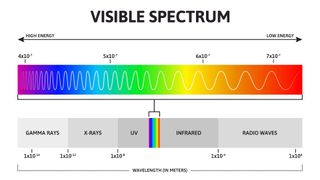
So, it's clear that nothing travels faster than light that we know of, but is there any situation where it might be possible? Einstein's theory of special relativity, and his subsequent theory of general relativity, is "built under the principle that the notions of space and time are relative," de Rham said. But what does this mean? "If someone [were] able to travel faster than light and carry information with them, their notion of time would be twisted as compared to ours," de Rham said. "There could be situations where the future could affect our past, and then the whole structure of reality would stop making sense."
This would indicate that it would probably not be desirable to make a human travel faster than the speed of light. But could it ever be possible? Will there ever be a time when we are capable of creating craft that could propel materials — and ultimately humans — through space at a pace that outstrips light speed? "Theorists have proposed various types of warp bubbles that could enable faster-than-light travel," Cassibry said.
But is de Rham convinced?
"We can imagine being able to communicate at the speed of light with systems outside our solar system ," de Rham said. "But sending actual physical humans at the speed of light is simply impossible, because we cannot accelerate ourselves to such speed.
"Even in a very idealistic situation where we imagine we could keep accelerating ourselves at a constant rate — ignoring how we could even reach a technology that could keep accelerating us continuously — we would never actually reach the speed of light," she added. "We could get close, but never quite reach it."
Related: How long is a galactic year?
This is a point confirmed by Cassibry. "Neglecting relativity, if you were to accelerate with a rate of 1G [Earth gravity], it would take you a year to reach the speed of light. However, you would never really reach that velocity because as you start to approach lightspeed, your mass energy increases, approaching infinite. "One of the few known possible 'cheat codes' for this limitation is to expand and contract spacetime, thereby pulling your destination closer to you. There seems to be no fundamental limit on the rate at which spacetime can expand or contract, meaning we might be able to get around this velocity limit someday."
— What would happen if the speed of light were much lower?
— What if the speed of sound were as fast as the speed of light?
— How does the rubber pencil illusion work?
Allain is similarly confident that going faster than light is far from likely, but, like Cassibry, noted that if humans want to explore distant planets, it may not actually be necessary to reach such speeds. "The only way we could understand going faster than light would be to use some type of wormhole in space," Allain said. "This wouldn't actually make us go faster than light, but instead give us a shortcut to some other location in space."
Cassibry, however, is unsure if wormholes will ever be a realistic option.
"Wormholes are theorized to be possible based on a special solution to Einstein's field equations," he said. "Basically, wormholes, if possible, would give you a shortcut from one destination to another. I have no idea if it's possible to construct one, or how we would even go about doing it." Originally published on Live Science.

Joe Phelan is a journalist based in London. His work has appeared in VICE, National Geographic, World Soccer and The Blizzard, and has been a guest on Times Radio. He is drawn to the weird, wonderful and under examined, as well as anything related to life in the Arctic Circle. He holds a bachelor's degree in journalism from the University of Chester.
James Webb telescope measures the starlight around the universe's biggest, oldest black holes for 1st time ever
Molecule responsible for robbing Venus of its water may finally have been identified
Scientists map the lost 'Atlantis' continent that lies off Australia
Most Popular
- 2 1,900-year-old Roman legionary fortress unearthed next to UK cathedral
- 3 China has launched a secret robot to the far side of the moon, new Chang'e 6 photos reveal
- 4 Hoard of 17th-century coins hidden during English Civil War unearthed during kitchen renovation
- 5 Epic NASA video takes you to the heart of a black hole — and destroys you in seconds
- 2 Siberia's 'gateway to the underworld' is growing a staggering amount each year
- 3 Hoard of 17th-century coins hidden during English Civil War unearthed during kitchen renovation
- 4 2,500-year-old Illyrian helmet found in burial mound likely caused 'awe in the enemy'
- 5 Record-shattering Tonga volcanic eruption wasn't triggered by what we thought, new study suggests
[Physics FAQ] - [Copyright]
By Philip Gibbs, 1997, 1998.
It might be thought that special relativity provides a short negative answer to this question. In actual fact, there are many trivial ways in which things can be going faster than light (FTL) in a sense, and there may be other more genuine possibilities. On the other hand, there are also good reasons to believe that real FTL travel and communication will always be unachievable. This article is not a full answer to the question (which no doubt will continue to be discussed in the newsgroups for the foreseeable future), but it does cover some of the more common points that are repeatedly made.
It is sometimes objected that "they said no-one would ever go faster than sound and they were wrong. Now they say no-one will ever go faster than light..." Actually it is probably not true that anybody said it was impossible to go faster than sound. It was known that rifle bullets go faster than sound long before an aircraft did. The truth is that some engineers once said that controlled flight faster than sound might be impossible, and they were wrong about that. FTL travel is a very different matter. It was inevitable that someone would one day succeed in flying faster than sound, once technology got around the problems. It is not inevitable that one day technology will enable us to go faster than light. Relativity has a lot to say about this. If FTL travel or FTL communication were possible, then causality would probably be violated and some very strange situations would arise.
First we will cover the trivial ways in which things can go FTL. These points are mentioned not because they are interesting, but because they come up time and time again when FTL is being discussed, and so they are necessary to deal with. Then we will think about what we mean by non-trivial FTL travel/communication and examine some of the arguments against it. Finally, we will look at some of the more serious proposals for real FTL. Many of these things are discussed in more detail elsewhere in the FAQ and hyper-links are provided. The sections are numbered so that they can be referred to individually.
Trivial FTL Travel
1. cherenkov effect.
One way to go faster than light is to make the light slow down! Light in vacuum travels at a speed c which is a universal constant (see the FAQ entry Is the speed of light constant? ), but in a dense medium such as water or glass, light slows down to c/n where n is the refractive index of the medium (1.0003 for air, 1.4 for water). It is certainly possible for particles to travel through air or water faster than light travels in that medium, and Cherenkov radiation is produced as a result. See the FAQ entry Is there an equivalent of the sonic boom for light? .
When we discuss moving faster than light, we are really talking about exceeding the speed of light in vacuum c (299,792,458 m/s). The Cherenkov effect is thus not considered to be a real example of FTL travel.
2. Third-Party Observers
If a rocket A is travelling away from me at 0.6c in a westerly direction, and another B is travelling away from me at 0.6c in an easterly direction, then the total distance between A and B as seen in my frame of reference is increasing at 1.2c . An apparent relative speed greater than c can be observed by a third person in this way.
But this is not what is normally meant by relative speeds. The true speed of rocket A relative to rocket B is the speed at which an observer in rocket B observes his distance from A to be increasing. The two speeds must be added using the relativistic formula for addition of velocities. (See the FAQ entry How do You Add Velocities in Special Relativity? ) In this case the relative speed is actually about 0.88c , so this is not an example of FTL travel.
3. Shadows and Light Spots
Think about how fast a shadow can move. If you project the shadow of your finger using a nearby lamp onto a distant wall and then wag your finger, the shadow will move much faster than your finger. If your finger moves parallel to the wall, the shadow's speed will be multiplied by a factor D/d where d is the distance from the lamp to your finger, and D is the distance from the lamp to the wall. The speed can even be much faster than this if the wall is at an angle to your finger's motion. If the wall is very far away, the movement of the shadow will be delayed because of the time it takes light to get there, but the shadow's speed is still increased by the same ratio. The speed of a shadow is therefore not restricted to be less than the speed of light.
This behaviour of a shadow is all about the arrival of successive "pieces of light" (photons, if you will) at a screen. It is really no different to the faster-than-light speed of a spot on the Moon's surface caused by a laser that has been aimed at that surface and is being waved around on Earth. Given that the distance to the Moon is 385,000 km, try working out the speed of that spot if you wave the laser at a gentle speed. You might also like to think about a water wave arriving obliquely at a long straight beach. How fast can the point at which the wave is breaking travel along the beach?
This sort of thing turns up in Nature; for example, the beam of light from a pulsar can sweep across a dust cloud. A bright explosion emits an expanding spherical shell of light or other radiation. When this shell intersects a surface, it creates a circle of light which expands faster than light. A natural example of this has been observed when an electromagnetic pulse from a lightning flash hits an upper layer of the atmosphere.
These are all examples of "things" that seem to be moving faster than light. In reality, no object or signal is moving faster that light here. For a more prosaic example, imagine squirting water from a garden hose at a fence, and moving your aim from one end of the fence to the other. The intersection point of water stream and fence moves quickly, but of course no thing or signal is really moving along the fence. A succession of water molecules strikes the fence, but their speed of travel has nothing to do with how quickly you move the hose. It is a kind of optical illusion for us to think that the wet spot advancing along the fence is a moving object or signal. The ban in relativity against faster-than-light travel actually concerns the speed of signals (which includes material objects and waves): in a vacuum, no signal is allowed to move faster than light moves in its vicinity. Neither a moving shadow, nor a laser spot, nor a wet spot on a fence, constitute a signal that is being sent from the initial position of those spots to the final position. Since these moving spots don't constitute a signal, they are all allowed to move faster than light. This is not really what we mean by faster-than-light travel, although it shows how difficult it is to define what we really do mean by faster-than-light travel. See also the FAQ The Superluminal Scissors .
4. Rigid Bodies
If you have a long rigid stick and you hit one end, wouldn't the other end have to move immediately? Would this not provide a means of FTL communication?
Well, it would if there were such things as perfectly rigid bodies. In practice the effect of hitting one end of the stick propagates along it at the speed of sound in the material; this speed depends on the stick's elasticity and density. Relativity places an absolute limit on material rigidity in such a way that the speed of sound in the material will not be greater than c .
The same principle applies if you hold a long string or rod vertically in a gravitational field and let go of the top end. The point at which you let go will start to move immediately, but the lower end cannot move until the effect has propagated down the length. That speed of propagation depends on the nature of the material and the strength of the gravitational field.
It is difficult to formulate a general theory of elastic materials in relativity, but the general principle can be illustrated with newtonian mechanics. The equation for longitudinal motion in an ideal elastic body can be derived from Hooke's law. In terms of the mass per unit length p and Young's modulus of elasticity Y , the longitudinal displacement X satisfies a wave equation (see for example Goldstein's "Classical Mechanics"):
Plane wave solutions travel at the speed of sound s where s 2 = Y/p . This wave equation does not allow any causal effect to propagate faster than s . Relativity therefore imposes a limit on elasticity: Y < pc 2 . In practice, no known material comes anywhere near this limit. Note that even if the speed of sound is near c , the matter does not necessarily move at relativistic speeds. But how can we know that no material can possibly exceed this limit? The answer is that all materials are made of particles whose interaction are governed by the standard model of particle physics, and no influence faster than light can propagate in that model (see the section on Quantum Field Theory below).
So although there is no such thing as a rigid body, there is such a thing as rigid body motion; but this is another example in the same category as the shadows and light spots described above which do not give FTL communication. (See also the FAQ articles The Superluminal Scissors and The Rigid Rotating Disk in Relativity ).
5. Phase, Group, and Signal Velocities
Look at this wave equation:
This has solutions of the form:
These solutions are sine waves propagating with a speed
But this is faster than light, so is this the equation for a tachyon field? (See the paragraph on tachyons below ). No, it is the usual relativistic equation for an ordinary particle with mass!
Superluminal speeds such as this present no problem once we recognise three types of speed associated with wave motion: phase velocity , group velocity , and signal velocity . Phase velocity is the velocity of waves that have well-defined wavelengths, and it often varies as a function of this wavelength. We can combine ("superpose") waves of different wavelengths to build a wave packet , a blob of some specified extent over which the wave disturbance is not small. This packet does not have a well-defined wavelength, and because it usually spreads out as it travels, it doesn't have a well-defined velocity either; but it does have representative velocity, and this is called its group velocity, which will usually be less than c . Each of the packet's constituent wave trains travels with its own individual phase velocity, which in some instances will be greater than c . But it is only possible to send information with such a wave packet at the group velocity (the velocity of the blob), so the phase velocity is yet another example of a speed faster than light that cannot carry a message.
In some situations, we can build a fairly exotic wave packet whose group velocity is greater than c . Does this then constitute an example of information being sent at a speed faster than light? It turns out that for these packets, information does not travel at the group velocity; instead, it travels at the signal velocity , which has to do with the time of arrival of the initial rise of the wave front as it reaches its destination. You might not now be surprised to learn that the signal velocity turns out always to be less than c .
6. Superluminal Galaxies
If something is coming towards you at nearly the speed of light and you measure its apparent speed without taking into account the diminishing time it takes light to reach you from the object, you can get an answer that is faster than light. This is an optical illusion, and is not due to the object's moving at FTL. See the FAQ Apparent Superluminal Velocity of Galaxies .
7. Relativistic Rocket
A controller based on Earth is monitoring a space ship moving away at a speed 0.8c . According to the theory of relativity, he will observe a time dilation that slows the ship's clocks by a factor of 5/3, even after he has taken into account the Doppler shift of signals coming from the space ship. If he works out the distance moved by the ship divided by the time elapsed as measured by the onboard clocks, he will get an answer of 4/3 c . He infers from this that the ship's occupants determine themselves to be traversing the distances between stars at speeds greater than the speed of light when measured with their clocks. From the point of view of the occupants their clocks undergo no slowing; rather, they maintain that it is the distance between the stars which has contracted by a factor of 5/3. So they also agree that they are covering the known distances between stars at 4/3 c .
This is a real effect which in principle could be used by space travellers to cover very large distances in their lifetimes. If they accelerate at a constant acceleration equal to the acceleration due to gravity on Earth, they would not only have a perfect artificial gravity on their ship, but would also be able to cross the galaxy in only about 12 years of their own "proper time": that is, they would age 12 years during the journey. See the FAQ What are the Equations for the Relativistic Rocket?
Nevertheless, this is not true FTL travel. The effective speed calculated used the distance in one reference frame and the time in another. This is no way to calculate a speed. Only the occupants of the ship benefit from this effective speed. The controller will not measure them to be travelling large distances in his own lifetime.
8. Speed of Gravity
Some people have argued that the speed of gravity in a gravitationally bound system is much greater than c or even infinite. In fact, gravitational effects and gravitational waves travel at the speed of light c . See the articles Does Gravity Travel at the Speed of Light? and What is Gravitational Radiation? for the explanation.

9. EPR Paradox
In 1935 Einstein, Podolsky, and Rosen published a thought experiment that seemed to produce a paradox in quantum mechanics, as well as demonstrating that it was incomplete. Their argument used the fact that there can be an apparent instantaneous interaction in the measurement of two separated particles that have been prepared in a certain "entangled" manner. Einstein called it "spooky action at a distance". It has been shown by Eberhard that no information can be passed using this effect; so there is no FTL communication, but the paradox is still very controversial. See the FAQ article The EPR Paradox and Bell's Inequality for more details.
10. Virtual Photons
In quantum field theory forces are mediated by "virtual particles". The Heisenberg Uncertainty Principle allows these virtual particles to move faster than light. But virtual particles are not called "virtual" for nothing. They are only part of a convenient mathematical notation, and once again, no real FTL travel or communication is possible. See the FAQ Virtual Particles .
11. Quantum Tunnelling
Quantum Tunnelling is the quantum mechanical effect that permits a particle to pass through a barrier when it does not have enough energy to do so classically. You can do a calculation of the time it takes a particle to tunnel through such a barrier. The answer you get can come out less than the time it takes light to cover the distance at speed c . Does this provide a means of FTL communication? Ref: T. E. Hartman, J. Appl. Phys. 33 , 3427 (1962).
The answer must surely be "No!"—otherwise our understanding of QED is very suspect. Yet a group of physicists have performed experiments that seem to suggest that FTL communication by quantum tunneling is possible. They claim to have transmitted Mozart's 40th Symphony through a barrier 11.4cm wide at a speed of 4.7 c . Their interpretation is, of course, very controversial. Most physicists say this is a quantum effect where no information can actually be passed at FTL speeds. If the effect is real it is difficult to see why it should not be possible to transmit signals into the past by placing the apparatus in a fast-moving frame of reference. Refs: W. Heitmann and G. Nimtz, Phys. Lett. A196 , 154 (1994); A. Enders and G. Nimtz, Phys. Rev. E48 , 632 (1993).
Terence Tao has pointed out that apparent FTL transmission of an audio signal over such a short distance is not very impressive. The signal takes less than 0.4 ns to travel the 11.4 cm at light speed, but it is quite easy to anticipate an audio signal ahead of time by up to 1000 ns simply by extrapolating the signal waveform. Although this is not what is being done in the above experiments, it does illustrate that the experimenters will need to use a much higher frequency random signal, or transmit over much larger distances, if they are to demonstrate FTL information transfer convincingly.
The likely conclusion is that there is no real FTL communication taking place, and that the effect is another manifestation of the Heisenberg Uncertainty Principle.
12. Casimir Effect
The Casimir Effect describes the fact that a very small but measurable force exists between two uncharged conducting plates when they are very close together. It is due to the existence of vacuum energy (see the FAQ article on the Casimir Effect ). A surprising calculation by Scharnhorst suggests that photons travelling across the gap between the plates in the Casimir Effect must go faster than c by a very very small amount (at best 1 part in 10 24 for a 1 nanometre gap.) It has been suggested that in certain cosmological situations, such as in the vicinity of cosmic strings if they exist, the effect could be much more pronounced. Even so, further theoretical investigations have shown that, once again, there is no possibility of FTL communication using this effect. Refs: K. Scharnhorst, Physics Letters B236 , 354 (1990) S. Ben-Menahem, Physics Letters B250 , 133 (1990) Andrew Gould (Princeton, Inst. Advanced Study). IASSNS-AST-90-25 Barton & Scharnhorst, J. Phys. A26 , 2037 (1993).
13. Expansion of the Universe
According to Hubble's Law, two galaxies that are a distance D apart are moving away from each other at a speed HD , where H is Hubble's constant. So this interpretation of Hubble's Law implies that two galaxies separated by a distance greater than c/H must be moving away from each other faster than light. Actually, the modern viewpoint describes this situation differently: general relativity takes the galaxies as being at rest relative to one another, while the space between them is expanding. In that sense, the galaxies are not moving away from each other faster than light; they are not moving away from each other at all! This change of viewpoint is not arbitrary; rather, it's in accord with the different but very fruitful view of the universe that general relativity provides. So the distance between two objects can be increasing faster than light because of the expansion of the universe, but this does not mean, in fact, that their relative speed is faster than light.
As was mentioned above, in special relativity it is possible for two objects to be moving apart by speeds up to twice the speed of light as measured by an observer in a third frame of reference. In general relativity even this limit can be surpassed, but it will not then be possible to observe both objects at the same time. Again, this is not real faster-than-light travel; it will not help anyone to travel across the galaxy faster than light. All that is happening is that the distance between two objects is increasing faster when taken in some cosmological reference frame.
14. The Moon revolves round my head faster than light!
Stand up in a clear space and spin round. It is not too difficult to turn at one revolution each two seconds. Suppose the Moon is on the horizon. How fast is it spinning round your head? It is about 385,000 km away, so the answer is 1.21 million km/s, which is more than four times the speed of light! It might sound ridiculous to say that the Moon is going round your head when really it is you who is turning, but according to general relativity all co-ordinate systems are equally valid, including rotating ones. So isn't the Moon going faster than light?
What it comes down to is the fact that velocities in different places cannot be compared directly in general relativity. Notice that the Moon is not overtaking any light in its own locality. The speed of the Moon can only be compared to the speeds of other objects in its own locality. Indeed, the concept of speed is not a very useful one in general relativity, and this makes it difficult to define what "faster than light" means. Even the statement that "the speed of light is constant" is open to interpretation in general relativity. Einstein himself, on page 76 of his book "Relativity: the Special and the General Theory", wrote that the statement cannot claim unlimited validity. When there is no absolute definition of time and distance it is not so clear how speeds should be determined.
Nevertheless, the modern interpretation is that the speed of light is constant in general relativity and this statement is a tautology given that standard units of distance and time are tied together using the speed of light. The Moon is given to be moving slower than light because it remains within the "future light cone" propagating from its position at any instant.
Relativity Arguments Against FTL Travel
15. what does "faster than light" mean.
The cases given so far only demonstrate how difficult it is to pin down exactly what we mean by FTL travel or communication. If we do not include things such as moving shadows, then what exactly do we mean by FTL?
In relativity there is no such thing as absolute velocity, only relative velocity; but there is a clear distinction between "world lines" that are "timelike", "lightlike", and "spacelike". By "world line" we mean a curve traced out in the four dimensions of space-time. Such a curve is the set of all events that make up the history of a particle. If a world line is spacelike then it describes something moving faster than light. So there is a clear meaning of what is meant by a "faster-than-light" speed which does not depend on the existence of third-party observers.
But what do we mean by an "object" if we don't want to include shadows? We could define an object to be anything that carries energy, charge, spin, or information; or perhaps just that it must be made of atoms, but there are technical problems in each case. In general relativity energy cannot be localised, so we had better avoid using energy in our definition. Charge and spin can be localised, but not every object need have charge or spin. Using the concept of information is better but tricky to define, and sending information faster than light is really just FTL communication—not FTL travel. Another difficulty is knowing whether an object seen at A is the same as the one that was earlier seen at B when we claim that it has travelled across the gap faster than light. Could it not be a duplicate? It could even be argued that FTL communication makes FTL travel possible, because you can send the blueprint for an object FTL as advance information, and then reconstruct the object—although not everyone would accept such teleportation as FTL travel.
The problems of specifying just what we mean by FTL are more difficult in general relativity. A valid form of FTL travel may mean distorting space-time (e.g. making a worm hole) to get from A to B without going on a spacelike curve locally. There is a distinction between going faster than light locally and getting from A to B faster than light globally . When a gravitational lens bends the light coming from a distant galaxy asymmetrically, the light coming round the galaxy on one side reaches us later than light that left at the same time and went round the other side. We must avoid a definition of FTL travel that says a particle going from A to B gets there before light that has made the same journey along a lightlike geodesic. This makes it very difficult, perhaps impossible, to define global FTL travel unambiguously.
If you were expecting me to finish this section with a precise definition of what is meant by FTL travel and FTL communication, I am afraid I must disappoint you! The above difficulties are insurmountable. Nonetheless, you will probably recognise the real thing when confronted with it now that I have given some examples of what would not be FTL travel.
16. The Infinite-Energy Argument
When Einstein wrote down his postulates for special relativity, he did not include the statement that you cannot travel faster than light. There is a misconception that it is possible to derive it as a consequence of the postulates he did give. Incidentally, it was Henri Poincare who said "Perhaps we must construct a new mechanics [...] in which the speed of light would become an impassable limit." That was in an address to the International Congress of Arts and Science in 1904—before Einstein announced special relativity in 1905.
It is a consequence of relativity that the energy of a particle of rest mass m moving with speed v is given by
As the speed approaches the speed of light, the particle's energy approaches infinity. Hence it should be impossible to accelerate an object with rest mass to the speed of light; also, particles with zero rest mass must always move at exactly the speed of light, since otherwise they would have no energy. This is sometimes called the "light speed barrier", but it is very different from the "sound speed barrier". As an aircraft approaches the speed of sound it starts to feel pressure waves which indicate that it is moving close to the speed of sound, and before the existence and effects of these waves were well understood, they destroyed several aircraft in the mid 20th century; hence the old name of sound "barrier". In fact, with more thrust and the right aerodynamics, an aircraft can certainly pass through the sound barrier.
The situation is different for light. As the light speed barrier is approached (in a perfect vacuum) there are no such waves according to relativity (destructive or otherwise). Moving at 0.999 c is just like standing still with everything rushing past you at −0.999 c . Particles are routinely pushed to these speeds and beyond in accelerators, so the theory is well established. Trying to attain the speed of light in this way is a matter of chasing something that is forever just out of your reach.
This explains why it is not possible to exceed the speed of light by ordinary mechanical means. But it does not in itself rule out FTL travel. It is really just one way in which things cannot be made to go faster than light, rather than a proof that there is no way to do so. Particles are known to decay instantly into other particles which fly off at high speed. It is not necessary to think in terms of the particles' having been accelerated, so how could we say that they could not go faster than light? What about the possibility of particles that might always have been moving faster than light, and which might be used to send information if they can be detected without ever slowing down to less than the speed of light? Even if such "tachyons" don't exist (and we don't believe that they do exist), there may be ways of moving matter from A to B faster than light is able to travel from A to B by the usual route, but without anything having to go at a FTL speed locally. See the paragraph on tachyons below .
17. Quantum Field Theory
Except for gravity, all physical phenomena are observed to comply with the "Standard Model" of particle physics. The Standard Model is a relativistic quantum field theory which incorporates the nuclear and electromagnetic forces as well as all the observed particles. In this theory, any pair of operators corresponding to physical observables at space-time events separated by a spacelike interval "commute" (i.e. their order can be reversed). In principle, this implies that effects cannot propagate faster than light in the standard model, and it can be regarded as the quantum field theory equivalent of the infinite energy argument.
But no completely rigorous proofs of anything exist in the quantum field theory of the Standard Model, since no one has yet succeeded in showing that the theory is completely self consistent; and in fact, most likely it is not! In any case, there is no guarantee that there are not other undiscovered particles and forces that disobey the no-FTL rule. Nor is there any generalisation that takes gravity and general relativity into account. Many physicists working on quantum gravity doubt that such simplistic expressions of causality and locality will be generalised. All told, there is no guarantee that light speed will be meaningful as a speed limit in a more complete theory that might arise in the future.
18. Grandfather Paradox
A better argument against FTL travel is the Grandfather Paradox. In special relativity, a particle moving FTL in one frame of reference will be travelling back in time in another. FTL travel or communication should therefore also give the possibility of travelling back in time or sending messages into the past. If such time travel is possible, you would be able to go back in time and change the course of history by killing your own grandfather. This is a very strong argument against FTL travel, but it leaves open the perhaps-unlikely possibility that we may be able to make limited journeys at FTL speed that did not allow us to come back. Or it may be that time travel is possible and causality breaks down in some consistent fashion when FTL travel is achieved. That is not very likely either, but if we are discussing FTL then we had better keep an open mind.
Conversely, if we could travel back in time we might also claim the ability to travel FTL, because we can go back in time and then travel at a slow speed to arrive somewhere before light got there by the usual route. See the FAQ article on Time Travel for more on this subject.
Open Possibilities for FTL Travel
In this last section I give a few of the speculative but serious suggestions for possible faster-than-light travel. These are not the kinds of thing usually included in the FAQ because they raise more questions than answers. They are included merely to make the point that serious research is being done in this direction. Only a brief introduction to each topic is given; more information can be found all over the Internet (and should, like almost everything on the Internet, be taken with a huge grain of salt!).
19. Tachyons
Tachyons are hypothetical particles that travel faster than light locally. Their mass must take on imaginary values (i.e. to do with the square root of −1) to be able to do so, but they have real-valued energy and momentum. Sometimes people imagine that such FTL particles would be impossible to detect, but there is no reason to think so. Shadows and spotlights suffice to show that there is no logic in this suggestion, because they can certainly go FTL and still be seen.
No tachyons have definitely been found and most physicists doubt their existence. There has been a claim that experiments to measure neutrino mass in tritium beta decay indicated that the neutrinos were tachyonic. ; while this is very doubtful, it is not entirely ruled out. Tachyon theories have problems because, apart from the possibility of causality violations, they destabilise the vacuum. It may be possible to get around such difficulties—but then we would not be able to use tachyons for the kind of FTL communication that we would like.
The truth is that most physicists consider tachyons to be a sign of pathological behaviour in field theories, and the interest in them among the wider public stems mostly from the fact that they are used so often in science fiction. See the FAQ article on Tachyons .
20. Worm Holes
A famous proposition for global FTL travel is to use "worm holes". Worm holes are shortcuts through space-time from one place in the universe to another which would permit you to go from one end to the other in a shorter time than it would take light passing by the usual route. Worm holes are a feature of classical general relativity, but to create them you have to change the topology of space-time. That might be possible within a theory of quantum gravity.
To keep a worm hole open, regions of negative energy would be needed. Misner and Thorne have suggested using the Casimir Effect on a grand scale to generate the negative energy, while Visser has proposed a solution involving cosmic strings. These are very speculative ideas which may simply not be possible. Exotic matter with negative energy may not exist in the form required.
Thorne has found that if worm holes can be created, then they can be used to construct closed timelike loops in space-time which would imply the possibility of time travel. It has been suggested that the "multiverse" interpretation of quantum mechanics (many universes co-existing) gets you out of trouble by allowing time to evolve differently if you succeed in going back to a previous time. But multiverses are entirely out of keeping with the Ockham's Razor approach to doing science, and constitute more of a popular interpretation of quantum mechanics than a serious physical theory. Hawking says that worm holes would simply be unstable and therefore unusable. The subject remains a fertile area for thought experiments that help clarify what is and what is not possible according to known and suggested laws of physics. Refs: W. G. Morris and K. S. Thorne, American Journal of Physics 56 , 395–412 (1988) W. G. Morris, K. S. Thorne, and U. Yurtsever, Phys. Rev. Letters 61 , 1446–9 (1988) Matt Visser, Physical Review D39 , 3182–4 (1989) See also "Black Holes and Time Warps", Kip Thorne, Norton & co. (1994) For an explanation of the multiverse see "The Fabric of Reality" David Deutsch, Penguin Press.
21. Warp Drives
A "warp drive" such as used in the Star Trek science fiction series would be a mechanism for warping space-time in such a way that an object could move faster than light. Miguel Alcubierre made himself famous by working out a space-time geometry which describes such a warp drive. The warp in space-time makes it possible for an object to go FTL while remaining on a timelike curve. The main catch is the same one that may stop us making large worm holes. To make such a warp, you would need exotic matter with negative energy density. Even if such exotic matter can exist, it is not clear how it could be deployed to make the warp drive work. Ref. M. Alcubierre, Classical and Quantum Gravity, 11 , L73–L77, (1994). Ref. S. Finazzi, S. Liberati, C. Barcel�, Semiclassical instability of dynamical warp drives at arxiv.org.
- To begin with, it is rather difficult to define exactly what is really meant by FTL travel and FTL communication. Many things such as shadows can go FTL, but not in a useful way that can carry information.
- There are several serious possibilities for real FTL which have been proposed in the scientific literature, but these always come with technical difficulties.
- The Heisenberg Uncertainty Principle tends to stop the use of apparent FTL quantum effects for sending information or matter.
- In general relativity there are potential means of FTL travel, but they may be impossible to make work. It is thought highly unlikely that engineers will be building space ships with FTL drives in the foreseeable future, if ever, but it is curious that theoretical physics as we presently understand it seems to leave the door open to the possibility.
- FTL travel of the sort science fiction writers would like is almost certainly impossible. For physicists the interesting question is "why is it impossible and what can we learn from that?"
share this!
March 9, 2021
Breaking the warp barrier for faster-than-light travel
by University of Göttingen
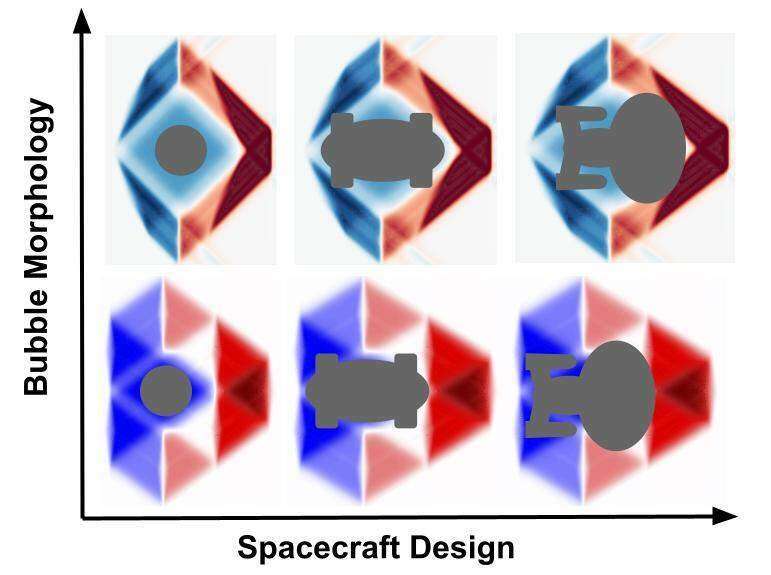
If travel to distant stars within an individual's lifetime is going to be possible, a means of faster-than-light propulsion will have to be found. To date, even recent research about superluminal (faster-than-light) transport based on Einstein's theory of general relativity would require vast amounts of hypothetical particles and states of matter that have 'exotic' physical properties such as negative energy density. This type of matter either cannot currently be found or cannot be manufactured in viable quantities. In contrast, new research carried out at the University of Göttingen gets around this problem by constructing a new class of hyper-fast 'solitons' using sources with only positive energies that can enable travel at any speed. This reignites debate about the possibility of faster-than-light travel based on conventional physics. The research is published in the journal Classical and Quantum Gravity .
The author of the paper, Dr. Erik Lentz, analyzed existing research and discovered gaps in previous 'warp drive' studies. Lentz noticed that there existed yet-to-be explored configurations of space-time curvature organized into 'solitons' that have the potential to solve the puzzle while being physically viable. A soliton—in this context also informally referred to as a 'warp bubble'—is a compact wave that maintains its shape and moves at constant velocity. Lentz derived the Einstein equations for unexplored soliton configurations (where the space-time metric's shift vector components obey a hyperbolic relation), finding that the altered space-time geometries could be formed in a way that worked even with conventional energy sources. In essence, the new method uses the very structure of space and time arranged in a soliton to provide a solution to faster-than-light travel , which—unlike other research—would only need sources with positive energy densities. No exotic negative energy densities needed.
If sufficient energy could be generated, the equations used in this research would allow space travel to Proxima Centauri, our nearest star, and back to Earth in years instead of decades or millennia. That means an individual could travel there and back within their lifetime. In comparison, the current rocket technology would take more than 50,000 years for a one-way journey. In addition, the solitons (warp bubbles) were configured to contain a region with minimal tidal forces such that the passing of time inside the soliton matches the time outside: an ideal environment for a spacecraft. This means there would not be the complications of the so-called 'twin paradox' whereby one twin traveling near the speed of light would age much more slowly than the other twin who stayed on Earth: in fact, according to the recent equations both twins would be the same age when reunited.
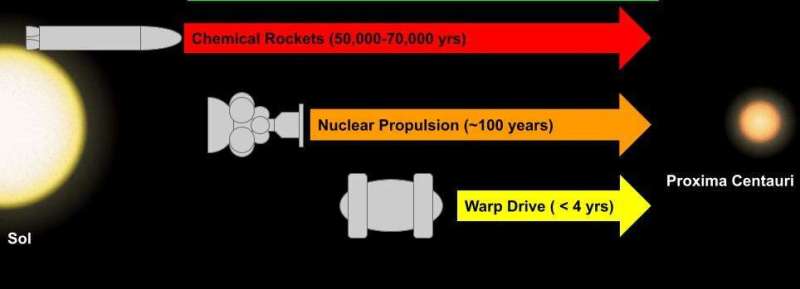
"This work has moved the problem of faster-than-light travel one step away from theoretical research in fundamental physics and closer to engineering. The next step is to figure out how to bring down the astronomical amount of energy needed to within the range of today's technologies, such as a large modern nuclear fission power plant. Then we can talk about building the first prototypes," says Lentz.
Currently, the amount of energy required for this new type of space propulsion drive is still immense. Lentz explains, "The energy required for this drive traveling at light speed encompassing a spacecraft of 100 meters in radius is on the order of hundreds of times of the mass of the planet Jupiter. The energy savings would need to be drastic, of approximately 30 orders of magnitude to be in range of modern nuclear fission reactors." He goes on to say: "Fortunately, several energy-saving mechanisms have been proposed in earlier research that can potentially lower the energy required by nearly 60 orders of magnitude." Lentz is currently in the early-stages of determining if these methods can be modified, or if new mechanisms are needed to bring the energy required down to what is currently possible.
Provided by University of Göttingen
Explore further
Feedback to editors

Solar storm puts on brilliant light show across the globe, but no serious problems reported
14 hours ago

Study discovers cellular activity that hints recycling is in our DNA

Weaker ocean currents lead to decline in nutrients for North Atlantic ocean life during prehistoric climate change

Research explores ways to mitigate the environmental toxicity of ubiquitous silver nanoparticles
15 hours ago

AI may be to blame for our failure to make contact with alien civilizations
18 hours ago

Saturday Citations: Dietary habits of humans; dietary habits of supermassive black holes; saving endangered bilbies
21 hours ago

Scientists unlock key to breeding 'carbon gobbling' plants with a major appetite
May 10, 2024

Clues from deep magma reservoirs could improve volcanic eruption forecasts

Study shows AI conversational agents can help reduce interethnic prejudice during online interactions

NASA's Chandra notices the galactic center is venting
Relevant physicsforums posts, eigenstates of particle with 1/2 spin (qbit).
10 hours ago
When and why can ∂p/∂t=0 in position space?
Epr in bohm formulation.
19 hours ago
How to enter measurement results into Bell inequality?
May 9, 2024
Why doesn't gravity cause double-slit decoherence?
May 8, 2024
Could energy be destroyed during particle annihilation?
May 5, 2024
More from Quantum Physics
Related Stories

A potential model for a real physical warp drive
Mar 4, 2021

Don't stop me now! Superluminal travel in Einstein's universe
Nov 27, 2015

There's no way to measure the speed of light in a single direction
Jan 11, 2021

Colliding solitons in optical microresonators to reveal important fundamental physics
Apr 24, 2020

High Altitude Water Cherenkov observatory tests speed of light
Mar 31, 2020
The trouble with rockets
Jan 5, 2018
Recommended for you

Quantum breakthrough sheds light on perplexing high-temperature superconductors

Scientists demonstrate the potential of electron spin to transmit quantum information

Ultrasound experiment identifies new superconductor

Topological phonons: Where vibrations find their twist

Physicist achieve milestone in quantum simulation with circular Rydberg qubits

Possible evidence of glueballs found during Beijing Spectrometer III experiments
Let us know if there is a problem with our content.
Use this form if you have come across a typo, inaccuracy or would like to send an edit request for the content on this page. For general inquiries, please use our contact form . For general feedback, use the public comments section below (please adhere to guidelines ).
Please select the most appropriate category to facilitate processing of your request
Thank you for taking time to provide your feedback to the editors.
Your feedback is important to us. However, we do not guarantee individual replies due to the high volume of messages.
E-mail the story
Your email address is used only to let the recipient know who sent the email. Neither your address nor the recipient's address will be used for any other purpose. The information you enter will appear in your e-mail message and is not retained by Phys.org in any form.
Newsletter sign up
Get weekly and/or daily updates delivered to your inbox. You can unsubscribe at any time and we'll never share your details to third parties.
More information Privacy policy
Donate and enjoy an ad-free experience
We keep our content available to everyone. Consider supporting Science X's mission by getting a premium account.
E-mail newsletter
An official website of the United States government
Official websites use .gov A .gov website belongs to an official government organization in the United States.
Strong geomagnetic storm reaches Earth, continues through weekend
NOAA space weather forecasters have observed at least seven coronal mass ejections (CMEs) from the sun, with impacts expected to arrive on Earth as early as midday Friday, May 10, and persist through Sunday, May 12, 2024.
NOAA’s Space Weather Prediction Center (SWPC) has issued a Geomagnetic Storm Warning for Friday, May 10. Additional solar eruptions could cause geomagnetic storm conditions to persist through the weekend.
- The First of Several CMEs reached Earth on Friday, May 10 at 12:37 pm EDT. The CME was very strong and SWPC quickly issued a series of geomagnetic storm warnings. SWPC observed G4 conditions at 1:39 pm EDT (G3 at 1:08 pm EDT).
- This storm is ongoing and SWPC will continue to monitor the situation and provide additional warnings as necessary.
This is an unusual and potentially historic event. Clinton Wallace , Director, NOAA’s Space Weather Prediction Center
CMEs are explosions of plasma and magnetic fields from the sun’s corona. They cause geomagnetic storms when they are directed at Earth. Geomagnetic storms can impact infrastructure in near-Earth orbit and on Earth’s surface , potentially disrupting communications, the electric power grid, navigation, radio and satellite operations. SWPC has notified the operators of these systems so they can take protective action.
Geomagnetic storms can also trigger spectacular displays of aurora on Earth . A severe geomagnetic storm includes the potential for aurora to be seen as far south as Alabama and Northern California.
Related Features //
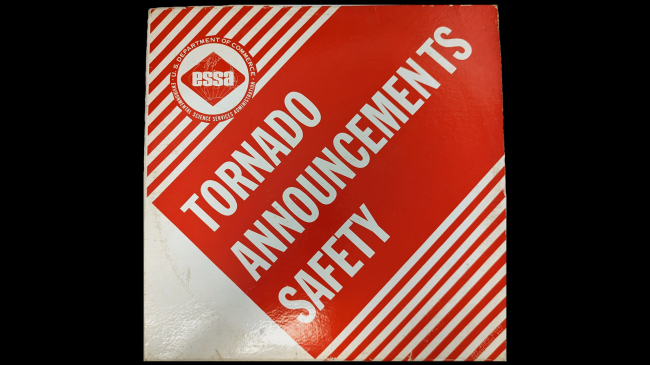
- Skip to main content
- Keyboard shortcuts for audio player
The huge solar storm is keeping power grid and satellite operators on edge

Geoff Brumfiel
Willem Marx

NASA's Solar Dynamics Observatory captured this image of solar flares early Saturday afternoon. The National Oceanic and Atmospheric Administration says there have been measurable effects and impacts from the geomagnetic storm. Solar Dynamics Observatory hide caption
NASA's Solar Dynamics Observatory captured this image of solar flares early Saturday afternoon. The National Oceanic and Atmospheric Administration says there have been measurable effects and impacts from the geomagnetic storm.
Planet Earth is getting rocked by the biggest solar storm in decades – and the potential effects have those people in charge of power grids, communications systems and satellites on edge.
The National Oceanic and Atmospheric Administration says there have been measurable effects and impacts from the geomagnetic storm that has been visible as aurora across vast swathes of the Northern Hemisphere. So far though, NOAA has seen no reports of major damage.

The Picture Show
Photos: see the northern lights from rare, solar storm.
There has been some degradation and loss to communication systems that rely on high-frequency radio waves, NOAA told NPR, as well as some preliminary indications of irregularities in power systems.
"Simply put, the power grid operators have been busy since yesterday working to keep proper, regulated current flowing without disruption," said Shawn Dahl, service coordinator for the Boulder, Co.-based Space Weather Prediction Center at NOAA.
NOAA Issues First Severe Geomagnetic Storm Watch Since 2005

- LISTEN & FOLLOW
- Apple Podcasts
- Google Podcasts
- Amazon Music
- Amazon Alexa
Your support helps make our show possible and unlocks access to our sponsor-free feed.
"Satellite operators are also busy monitoring spacecraft health due to the S1-S2 storm taking place along with the severe-extreme geomagnetic storm that continues even now," Dahl added, saying some GPS systems have struggled to lock locations and offered incorrect positions.
NOAA's GOES-16 satellite captured a flare erupting occurred around 2 p.m. EDT on May 9, 2024.
As NOAA had warned late Friday, the Earth has been experiencing a G5, or "Extreme," geomagnetic storm . It's the first G5 storm to hit the planet since 2003, when a similar event temporarily knocked out power in part of Sweden and damaged electrical transformers in South Africa.
The NOAA center predicted that this current storm could induce auroras visible as far south as Northern California and Alabama.
Extreme (G5) geomagnetic conditions have been observed! pic.twitter.com/qLsC8GbWus — NOAA Space Weather Prediction Center (@NWSSWPC) May 10, 2024
Around the world on social media, posters put up photos of bright auroras visible in Russia , Scandinavia , the United Kingdom and continental Europe . Some reported seeing the aurora as far south as Mallorca, Spain .
The source of the solar storm is a cluster of sunspots on the sun's surface that is 17 times the diameter of the Earth. The spots are filled with tangled magnetic fields that can act as slingshots, throwing huge quantities of charged particles towards our planet. These events, known as coronal mass ejections, become more common during the peak of the Sun's 11-year solar cycle.
A powerful solar storm is bringing northern lights to unusual places
Usually, they miss the Earth, but this time, NOAA says several have headed directly toward our planet, and the agency predicted that several waves of flares will continue to slam into the Earth over the next few days.
While the storm has proven to be large, predicting the effects from such incidents can be difficult, Dahl said.
Shocking problems
The most disruptive solar storm ever recorded came in 1859. Known as the "Carrington Event," it generated shimmering auroras that were visible as far south as Mexico and Hawaii. It also fried telegraph systems throughout Europe and North America.

Stronger activity on the sun could bring more displays of the northern lights in 2024
While this geomagnetic storm will not be as strong, the world has grown more reliant on electronics and electrical systems. Depending on the orientation of the storm's magnetic field, it could induce unexpected electrical currents in long-distance power lines — those currents could cause safety systems to flip, triggering temporary power outages in some areas.
my cat just experienced the aurora borealis, one of the world's most radiant natural phenomena... and she doesn't care pic.twitter.com/Ee74FpWHFm — PJ (@kickthepj) May 10, 2024
The storm is also likely to disrupt the ionosphere, a section of Earth's atmosphere filled with charged particles. Some long-distance radio transmissions use the ionosphere to "bounce" signals around the globe, and those signals will likely be disrupted. The particles may also refract and otherwise scramble signals from the global positioning system, according to Rob Steenburgh, a space scientist with NOAA. Those effects can linger for a few days after the storm.
Like Dahl, Steenburgh said it's unclear just how bad the disruptions will be. While we are more dependent than ever on GPS, there are also more satellites in orbit. Moreover, the anomalies from the storm are constantly shifting through the ionosphere like ripples in a pool. "Outages, with any luck, should not be prolonged," Steenburgh said.

What Causes The Northern Lights? Scientists Finally Know For Sure
The radiation from the storm could have other undesirable effects. At high altitudes, it could damage satellites, while at low altitudes, it's likely to increase atmospheric drag, causing some satellites to sink toward the Earth.
The changes to orbits wreak havoc, warns Tuija Pulkkinen, chair of the department of climate and space sciences at the University of Michigan. Since the last solar maximum, companies such as SpaceX have launched thousands of satellites into low Earth orbit. Those satellites will now see their orbits unexpectedly changed.
"There's a lot of companies that haven't seen these kind of space weather effects before," she says.
The International Space Station lies within Earth's magnetosphere, so its astronauts should be mostly protected, Steenburgh says.
In a statement, NASA said that astronauts would not take additional measures to protect themselves. "NASA completed a thorough analysis of recent space weather activity and determined it posed no risk to the crew aboard the International Space Station and no additional precautionary measures are needed," the agency said late Friday.

People visit St Mary's lighthouse in Whitley Bay to see the aurora borealis on Friday in Whitley Bay, England. Ian Forsyth/Getty Images hide caption
People visit St Mary's lighthouse in Whitley Bay to see the aurora borealis on Friday in Whitley Bay, England.
While this storm will undoubtedly keep satellite operators and utilities busy over the next few days, individuals don't really need to do much to get ready.
"As far as what the general public should be doing, hopefully they're not having to do anything," Dahl said. "Weather permitting, they may be visible again tonight." He advised that the largest problem could be a brief blackout, so keeping some flashlights and a radio handy might prove helpful.
I took these photos near Ranfurly in Central Otago, New Zealand. Anyone can use them please spread far and wide. :-) https://t.co/NUWpLiqY2S — Dr Andrew Dickson reform/ACC (@AndrewDickson13) May 10, 2024
And don't forget to go outside and look up, adds Steenburgh. This event's aurora is visible much further south than usual.
A faint aurora can be detected by a modern cell phone camera, he adds, so even if you can't see it with your eyes, try taking a photo of the sky.
The aurora "is really the gift from space weather," he says.
- space weather
- solar flares
- solar storm
Solar storm heading to Earth could disrupt communications and bring northern lights to California
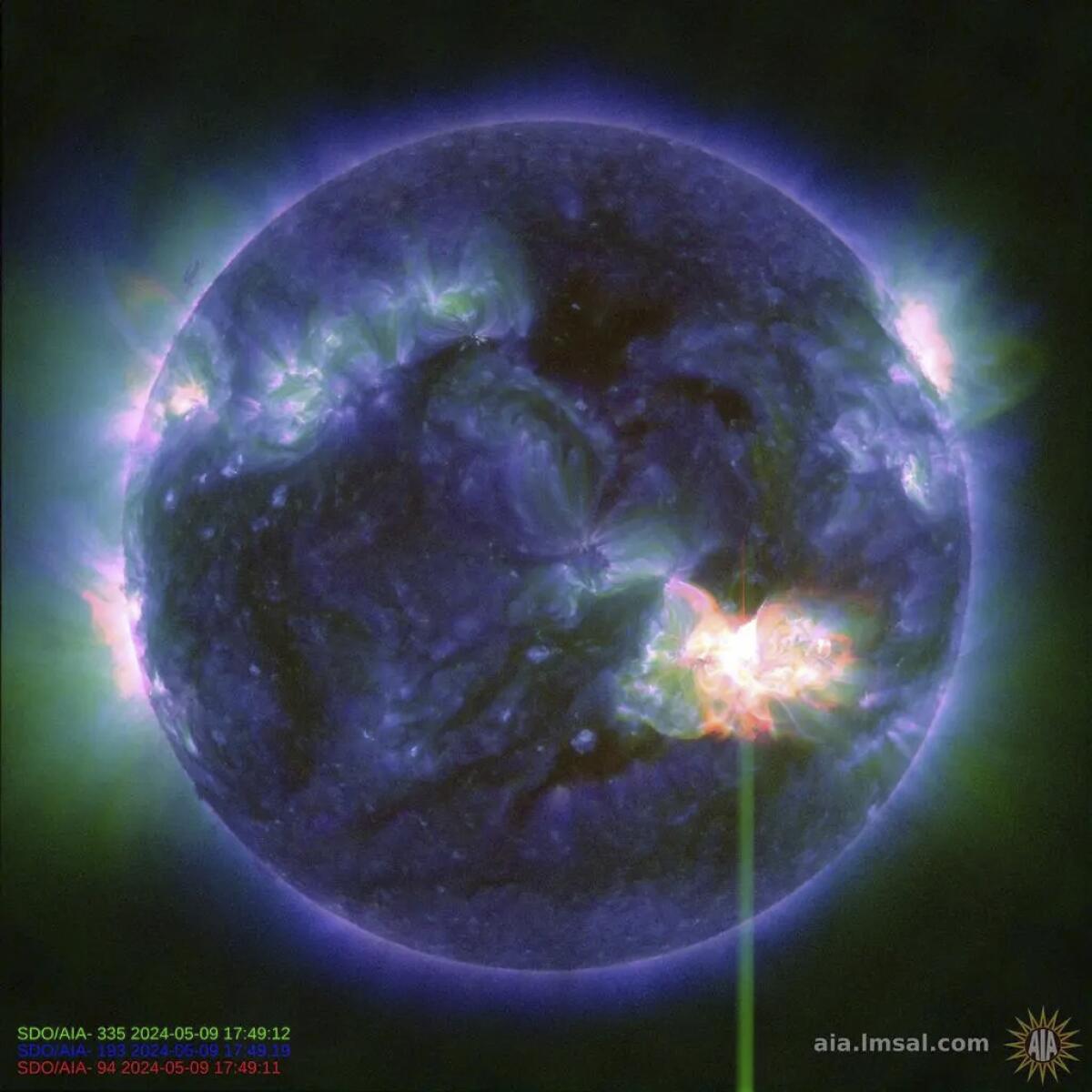
- Show more sharing options
- Copy Link URL Copied!
A different kind of storm could complicate this weekend’s plans .
For the first time since January 2005, the U.S. National Oceanic and Atmospheric Administration has issued a severe geomagnetic storm watch for Friday evening.
The category G4 watch from NOAA’s Space Weather Prediction Center signals the possibility that a concentration of energy flaring from the sun could disturb our planet’s electromagnetic field once it reaches Earth.
A geomagnetic storm of this size could disrupt communications, like the 2003 event that caused blackouts in Sweden and damaged South Africa’s power grid .
More promisingly, super-charged collisions of solar energy into the gas of our atmosphere creates the dazzling phenomena of aurora borealis , or the northern lights. Typically confined to polar regions, the colorful display could be visible this weekend as far south as Northern California.
“We have a very rare event on our hands,” space weather forecaster Shawn Dahl of SWPC said during a news conference Friday morning.

Science & Medicine
After months of silence, Voyager 1 has returned NASA’s calls
The spacecraft launched in 1977 and is now 15 billion miles from Earth. It went silent in November. Scientists at JPL figured out how to get it talking again.
April 23, 2024
A geomagnetic storm happens when energy from solar wind — the high-speed current of atomic particles the sun is constantly flinging into space — is transferred into the electromagnetic field that surrounds Earth.
The winds of a Category 5 hurricane on our puny little planet can exceed 150 miles per hour. In contrast, solar wind averages about 870,000 miles per hour all day, every day according to NASA .
Earth’s electromagnetic field deflects the majority of these particles, save for those interactions in the polar areas that produce the northern lights. But unusually intense or concentrated eruptions of energy on the surface of the Sun can disrupt that equilibrium, causing geomagnetic storms like the one potentially headed our way.
On Wednesday morning, astronomers noted a series of solar flares and coronal mass ejections — essentially, giant explosions of energy — emanating from a massive sunspot more than 15 times the diameter of Earth.
The Space Weather Prediction Center has observed seven coronal mass ejections, or CMEs, heading in Earth’s direction, said Mike Bettwy, operations chief at SWPC.
First G4 (Severe) geomagnetic since 2005 has been issued. The aurora tonight (5/10) /tomorrow morning (5/11) may become visible over much of the northern half of the country, & possibly as far south as Alabama to northern California. https://t.co/upPlNYuNev @NWSSWPC @NWS pic.twitter.com/JTHmXtRKOc — NOAA (@NOAA) May 10, 2024
“Based on the data we have, all seven of these are going to be spewing that energy toward us,” Bettwy said.
The energy in these various eruptions is expected to merge and reach the Earth’s magnetic field late Friday or early Saturday.
“Our level of confidence is high that we will have an arrival of these CMEs as early as this evening,” Dahl said. The precise time they’ll arrive is less certain.
SPWC will have more clear information once that solar energy reaches NASA’s Advanced Composition Explorer spacecraft , a satellite about 1 million miles from Earth.
Yet “even though that sounds like it’s far away . . . it doesn’t necessarily give us a ton of lead time,” Bettwy said. Given that solar wind is moving faster than the speed of sound, it will reach Earth only 20 to 45 minutes after passing that 1-million-mile marker in space.
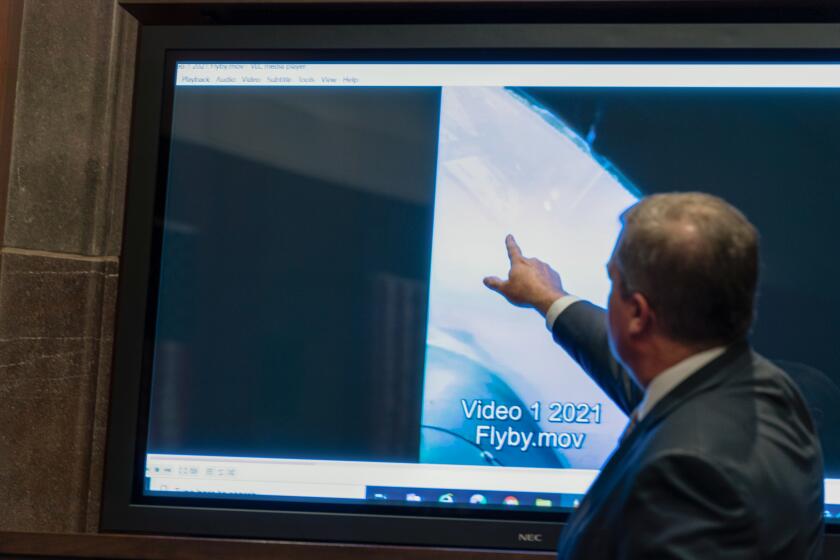
NASA says the truth is out there on UFOs. It hired a UAP research chief to find it
NASA’s new instruction to the U.S. public regarding unidentified anomalous phenomena boils down to a version of the popular security slogan: “If you see something, say something.”
Sept. 14, 2023
Scientists have previously warned that the strongest geomagnetic storms could wreak havoc on our power and communication systems. That is not what’s expected in this case.
Those of us here on Earth may experience power outages and minor internet or GPS glitches, Bettwy said.
“Geomagnetic storms can impact infrastructure in near-Earth orbit and on Earth’s surface, potentially disrupting communications, the electric power grid, navigation, radio and satellite operations,” NOAA said in a statement . “SWPC has notified the operators of these systems so they can take protective action.”
Watches for milder geomagnetic storms are fairly common. In March, a geomagnetic storm briefly reached G4 strength for a few hours .
That event was the third geomagnetic storm to reach G4 status during the current 11-year solar cycle , which began in 2019, according to the SWPC. At that time, the agency said the event posed no risk of adverse impacts to the public.
“What’s unique about what is potentially about to hit us is that it’s a much more significant event, in terms of what’s going to be hitting the atmosphere,” Bettwy said.

Space shuttle Endeavour is lifted into the sky, takes final position as star of new museum wing
A shrink-wrapped Endeavour was hoisted and then carefully placed in its final location Tuesday at the still-under-construction Samuel Oschin Air and Space Center.
Jan. 30, 2024
More to Read

Northern lights appear in L.A. County skies this weekend
May 11, 2024

Rockets? Meteors? UFOs? Here’s what really caused Tuesday morning’s sky show
April 2, 2024

Geomagnetic storm severe enough to bring northern lights to California?
March 24, 2024

Corinne Purtill is a science and medicine reporter for the Los Angeles Times. Her writing on science and human behavior has appeared in the New Yorker, the New York Times, Time Magazine, the BBC, Quartz and elsewhere. Before joining The Times, she worked as the senior London correspondent for GlobalPost (now PRI) and as a reporter and assignment editor at the Cambodia Daily in Phnom Penh. She is a native of Southern California and a graduate of Stanford University.
More From the Los Angeles Times

Homelessness down in Long Beach, up in Orange County, latest counts find

A Long Beach man started a petition to ban Airbnb in his neighborhood — and it worked

Burning Man, home of ‘radical self-expression,’ removes pro-Palestinian sculpture from its website

Company Town
Netflix is in the running for NFL Christmas games
May 10, 2024
- Share full article
Advertisement
Supported by
But How Does the Worm Get in Your Brain?
And other questions about parasites.

By Dana G. Smith and Dani Blum
Robert F. Kennedy Jr.’s disclosure that a doctor apparently found a dead worm in his brain has sparked questions about what brain parasites are, the damage they can cause and how, exactly, they get there.
How do parasites turn up in people? And what can they do to the brain?
Brain parasites encompass far more than worms. There are “legions” of organisms that can affect the brain, said Scott Gardner, a professor of biological sciences at the University of Nebraska-Lincoln who specializes in parasites. In addition to worms, common brain parasites include single-celled organisms such as Toxoplasma gondii and some amoebas.
The damage varies depending on the type of parasite and where it ends up in the brain. “Some of them actively invade the tissues and destroy tissues,” said Dr. Daniel Pastula, chief of neuro-infectious diseases and global neurology at University of Colorado Medicine. Others cause problems because of the inflammatory reaction that they trigger.
Humans are typically exposed to tapeworms through raw or undercooked food or through food contaminated with feces.
“A lot of these things are transmitted to humans through feces,” said Dr. Edith L. Graham, a neurologist at Northwestern Medicine.
Doctors consulted by The New York Times speculated that Mr. Kennedy described symptoms of an infection with larvae from the pork tapeworm, Taenia solium, one of multiple types of tapeworm that can infect the brain. When a person accidentally swallows pork tapeworm eggs, the eggs hatch in the intestines, and the larvae can travel to other organs, including the brain. There, they form cysts, causing a condition known as neurocysticercosis .
It can take months, or even years, for people to show signs of infection. Symptoms vary based on how many cysts develop and where they are. (Cysts can form in the eyes, muscles and spinal cord.) Generally, though, people with neurocysticercosis experience headaches and seizures, and they sometimes feel confused, struggle to pay attention and have issues with balance. The condition can be fatal.
Another type of parasite that can affect the brain is known as a brain-eating amoeba . Infections of this kind are extremely rare but can lead to a potentially fatal swelling of the brain or spinal cord, said Tajie H. Harris, an associate professor of neuroscience at the University of Virginia. The organisms enter through the nose when people swim in lakes and rivers, and then travel to the brain. People have also been infected through using neti pots or other sinus rinses with untreated or non-sterile water.
Toxoplasma gondii
One of the most common parasitic brain infections is toxoplasmosis. Over 40 million people in the United States may be infected with the parasite that causes that infection, according to the Centers for Disease Control and Prevention . People can be infected by eating undercooked meat or shellfish that is contaminated, by drinking contaminated water or by accidentally swallowing the parasite when they encounter it in cat feces, as when cleaning litter boxes.
The parasite that causes toxoplasmosis can linger in humans for years — potentially, for someone’s entire life — but most people will not develop symptoms. “For the most part, our immune system does an amazing job at just handling and dealing with this parasite, allowing us to live our lives without ever knowing,” Dr. Harris said.
But it can make some people feel like they have the flu. People with compromised immune systems are at risk of serious illness and brain damage if infected, and developing fetuses can be severely affected if pregnant women are exposed. (That’s why doctors sometimes advise pregnant women to avoid coming into contact with cat litter.)
How do you figure out if you have a parasite?
“You wouldn’t know yourself, unless someone is looking,” Dr. Gardner said. Sometimes a patient’s blood can be tested for antibodies that are produced in response to a parasite. In other cases, doctors diagnose infections with an M.R.I. or C.T. scan.
Treatment options vary because infections span such a wide range. Many are treatable with antiparasitic drugs, which patients may need to take for weeks. Doctors may also prescribe steroids to help with inflammation. Some patients will undergo surgery to remove cysts.
In the United States, severe infections from brain parasites are rare, Dr. Pastula said, “but in other parts of the world, they’re more common.”
Fortunately, many of these infections are preventable, Dr. Pastula said. To lower your risk, especially while traveling internationally, he advised washing hands thoroughly before you eat or prepare food, cooking food properly and ensuring that the water you’re drinking is clean.
Dana G. Smith is a Times reporter covering personal health, particularly aging and brain health. More about Dana G. Smith
Dani Blum is a health reporter for The Times. More about Dani Blum

IMAGES
VIDEO
COMMENTS
Bottom line: If humanity wants to travel between stars, people are going to need to travel faster than light. New research suggests that it might be possible to build warp drives and beat the ...
The field equations of Einstein's General Relativity theory say that faster-than-light (FTL) travel is possible, so a handful of researchers are working to see whether a Star Trek-style warp drive, or perhaps a kind of artificial wormhole, could be created through our technology. But even if shown feasible tomorrow, it's possible that designs for an FTL system could be as far ahead of a ...
Faster than light travel is the only way humans could ever get to other stars in a reasonable amount of time. ... But so far, faster-than-light travel is possible only in science fiction.
New research suggests that it might be possible to build warp drives and beat the galactic speed limit. Faster than light travel is the only way humans could ever get to other stars in a ...
The proposed engine could not achieve faster-than-light travel, though it could come close; the statement mentions "high but subluminal speeds." ... Warp drives' may actually be possible someday ...
Symmetry is a physics concept that goes all the way back to Galileo's time. The secret to faster-than-light physics could be to double down on the number of dimensions. Specifically, the ...
There are still plenty of puzzles to solve, but the free-flow of these kinds of ideas remains our best hope of ever getting a chance to visit those distant, twinkling stars. "This work has moved the problem of faster-than-light travel one step away from theoretical research in fundamental physics and closer to engineering," Lentz said.
In layman's terms, the Alcubierre Drive achieves FTL travel by stretching the fabric of space-time in a wave, causing the space ahead of it to contract while the space behind it expands. In theory, a spacecraft inside this wave would be able to ride this "warp bubble" and achieve velocities beyond the speed of light.
Bending space into warp bubbles to travel faster than light may never be a reality, but distorting the flow of time just might be possible. New warp drive research dashes faster than light travel ...
Here's How. Scientists Believe Light Speed Travel Is Possible. Here's How. A functioning warp drive would allow humans to reach the far ends of the cosmos in the blink of an eye. n late 2020 ...
If travel to distant stars within an individual's lifetime is going to be possible, a means of faster-than-light propulsion will have to be found. To date, even recent research about superluminal (faster-than-light) transport based on Einstein's theory of general relativity would require vast amounts of hypothetical particles and states of ...
Faster-than-light "warp drives" may be theoretically possible, but they usually involve exotic physics well out of our reach. ... Faster-than-light (FTL) travel is a staple of sci-fi, hand ...
Faster-than-light travel: Is warp drive really possible? - BBC Science Focus Magazine.
1. Hyperdrive. Popularized by Star Wars and used extensively in fiction, a hyperdrive enables a spaceship to travel at FTL speeds by entering another dimension known as "hyperspace.". The ...
General relativity also recognizes that any means of faster-than-light travel could also be used for time travel. This raises problems with causality. ... Usenet Physics FAQ: is FTL travel or communication Possible? Relativity, FTL and causality; Yan, Kun (2006). "The tendency analytical equations of stable nuclides and the superluminal ...
Traveling faster than light - or as scientists call it, FTL - has long been a staple of science fiction; but according to Einstein's theory of relativity, it's an impossible task. However, new research proposes several methods through which FTL travel might be possible . While these ideas are exciting, there are significant hurdles to ...
Their calculations further indicated that this could be done with a negative vacuum energy density roughly equivalent to the size of Jupiter (1.898×1024 kg; 4.18×1024 lbs).
So, according to de Rham, the only thing capable of traveling faster than the speed of light is, somewhat paradoxically, light itself, though only when not in the vacuum of space. Of note ...
It could even be argued that FTL communication makes FTL travel possible, because you can send the blueprint for an object FTL as advance information, and then reconstruct the object—although not everyone would accept such teleportation as FTL travel.
If travel to distant stars within an individual's lifetime is going to be possible, a means of faster-than-light propulsion will have to be found. To date, even recent research about superluminal ...
Yes, going by general relativity, it requires "infinite energy," but that's not even the hard part. The hard part is that any kind of FTL, actual or apparent, nullifies causality. There's a reason sci-fi FTL handwavium always focuses on how they've worked around the infinite energy problem, but never the causality problem.
Additional solar eruptions could cause geomagnetic storm conditions to persist through the weekend. The First of Several CMEs reached Earth on Friday, May 10 at 12:37 pm EDT. The CME was very strong and SWPC quickly issued a series of geomagnetic storm warnings. SWPC observed G4 conditions at 1:39 pm EDT (G3 at 1:08 pm EDT).
The huge solar storm is keeping power grid and satellite operators on edge. NASA's Solar Dynamics Observatory captured this image of solar flares early Saturday afternoon. The National Oceanic and ...
Solar storm heading to Earth could disrupt communications and bring northern lights to California. NASA's Solar Dynamics Observatory captured a view of a solar flare Thursday. A severe ...
Increased solar activity could cause auroras as far south as Alabama and Northern California, but may disrupt communications on Earth tonight and over the weekend.
This is an area that attracts plenty of bright ideas, each offering a different approach to solving the puzzle of faster-than-light travel: achieving a means of sending something across space at superluminal speeds.. Hypothetical travel times to Proxima Centauri, the nearest-known star to the Sun. (E. Lentz) There are some problems with this notion, however.
And other questions about parasites. By Dana G. Smith and Dani Blum Robert F. Kennedy Jr.'s disclosure that a doctor apparently found a dead worm in his brain has sparked questions about what ...